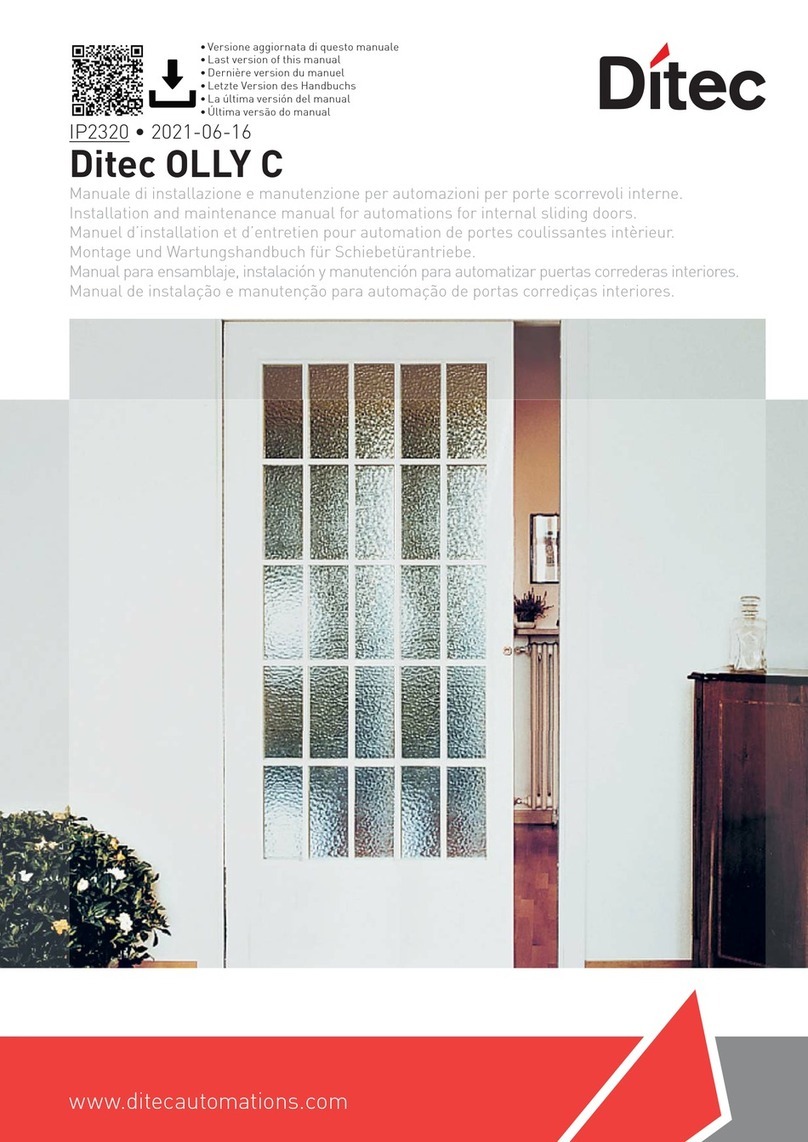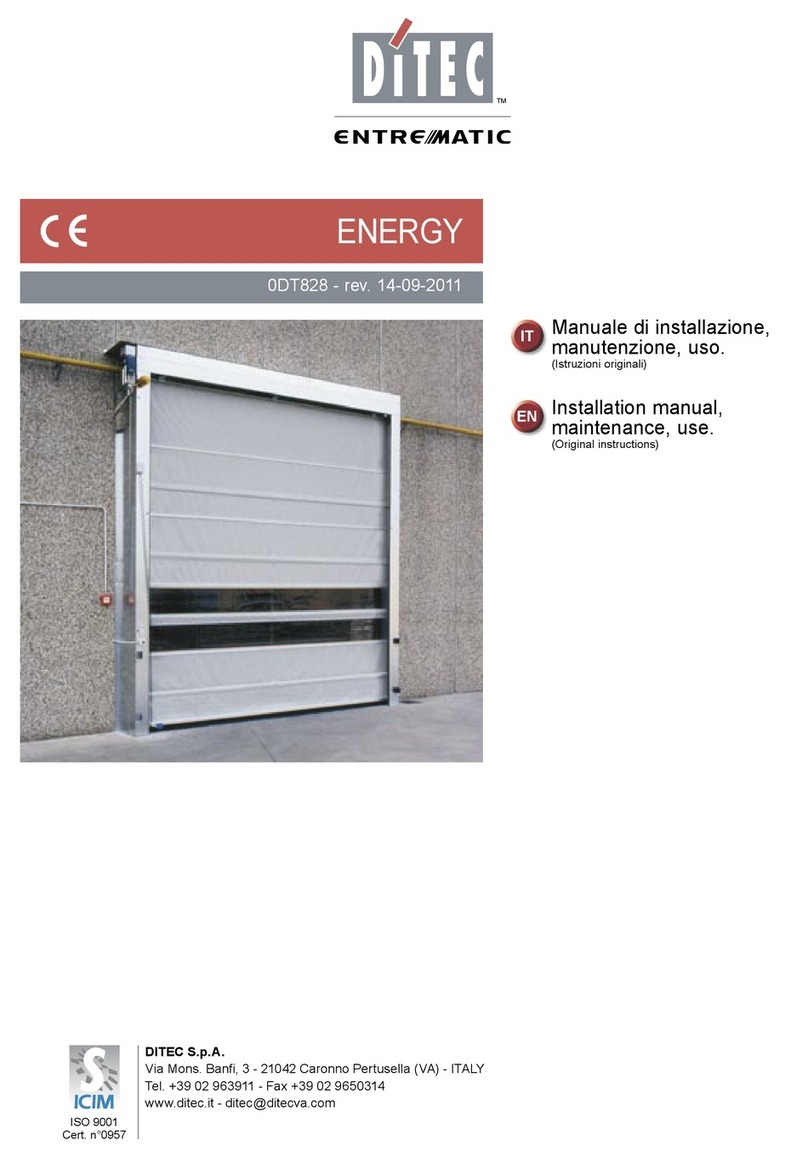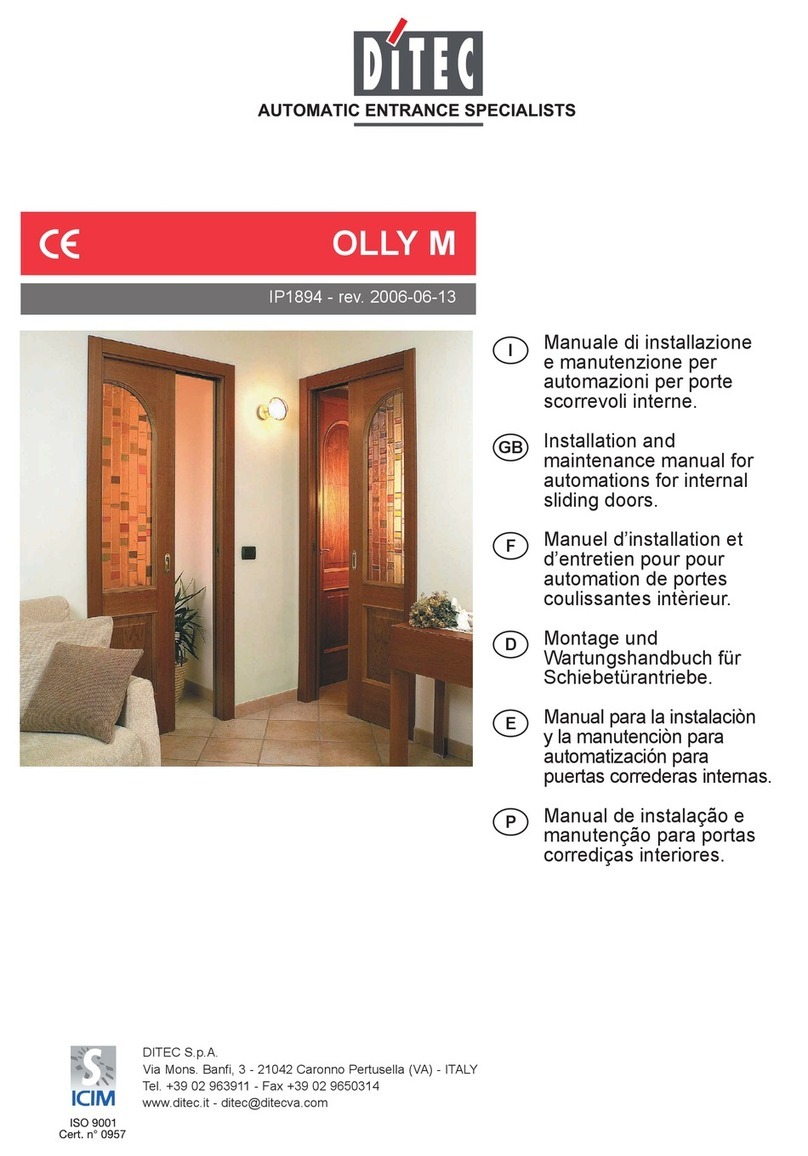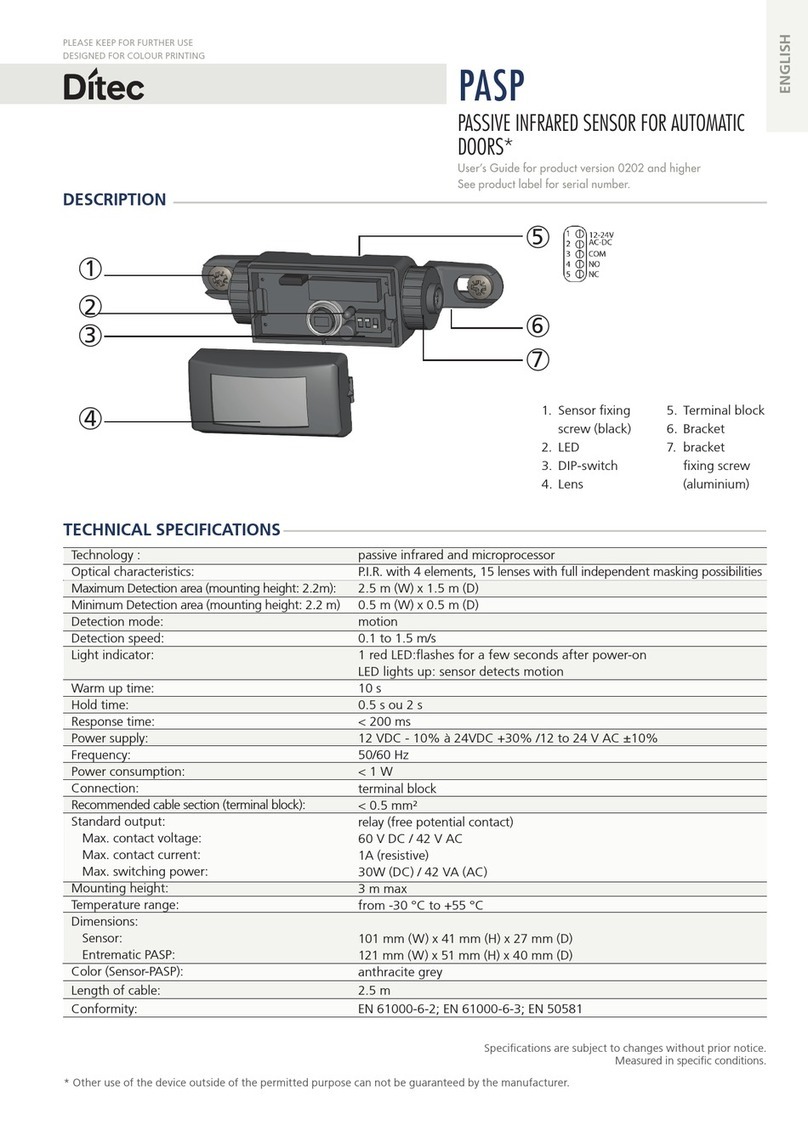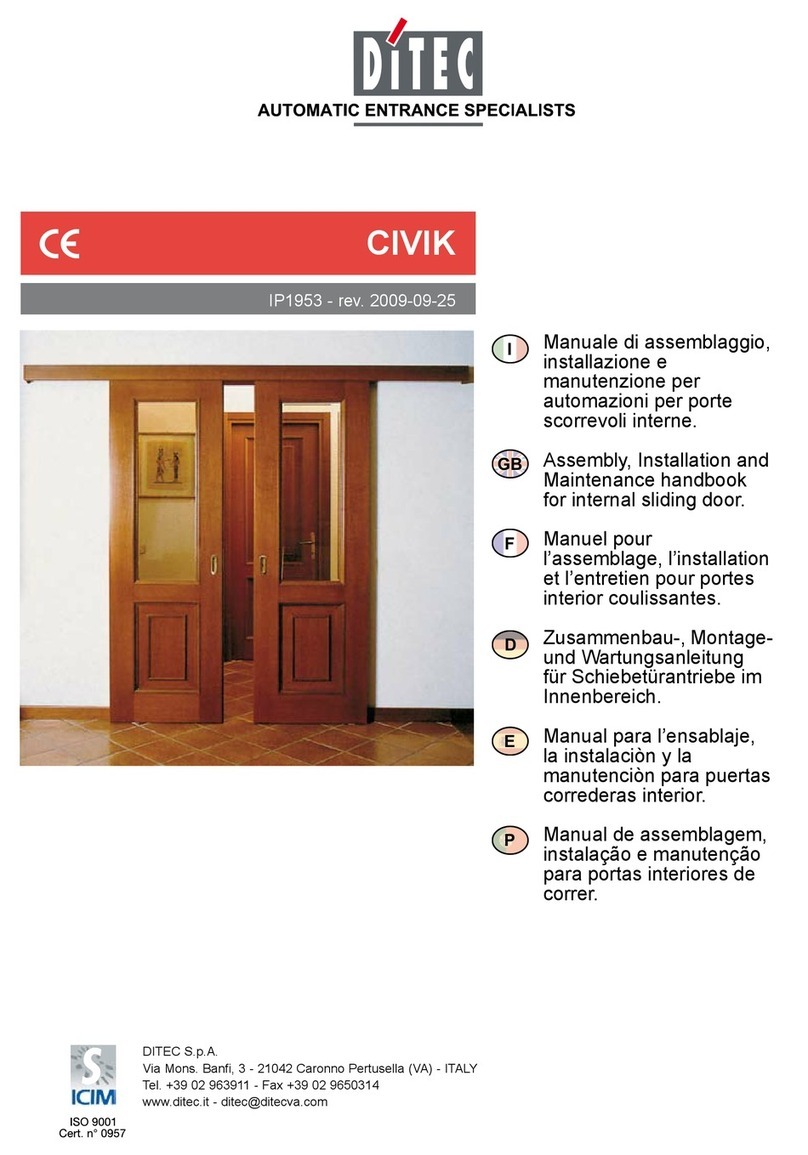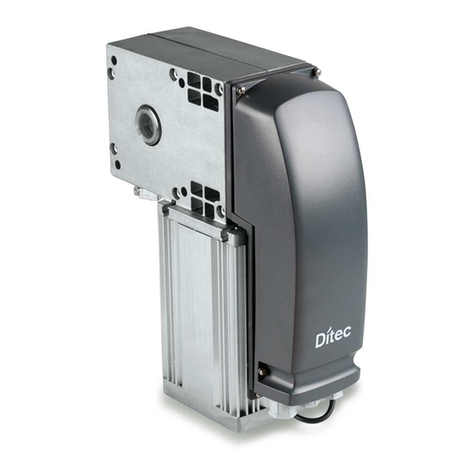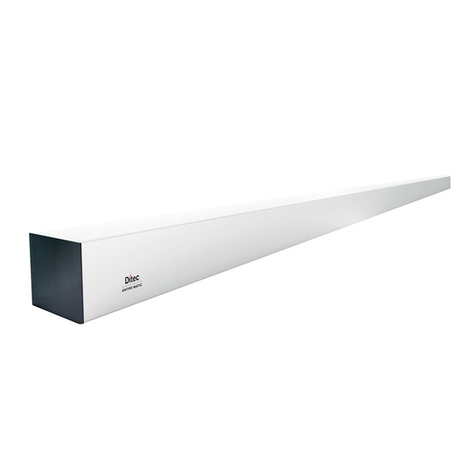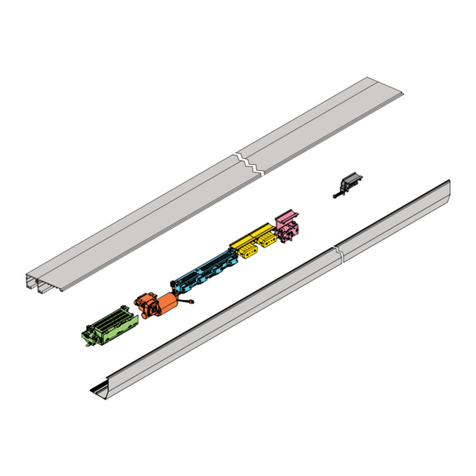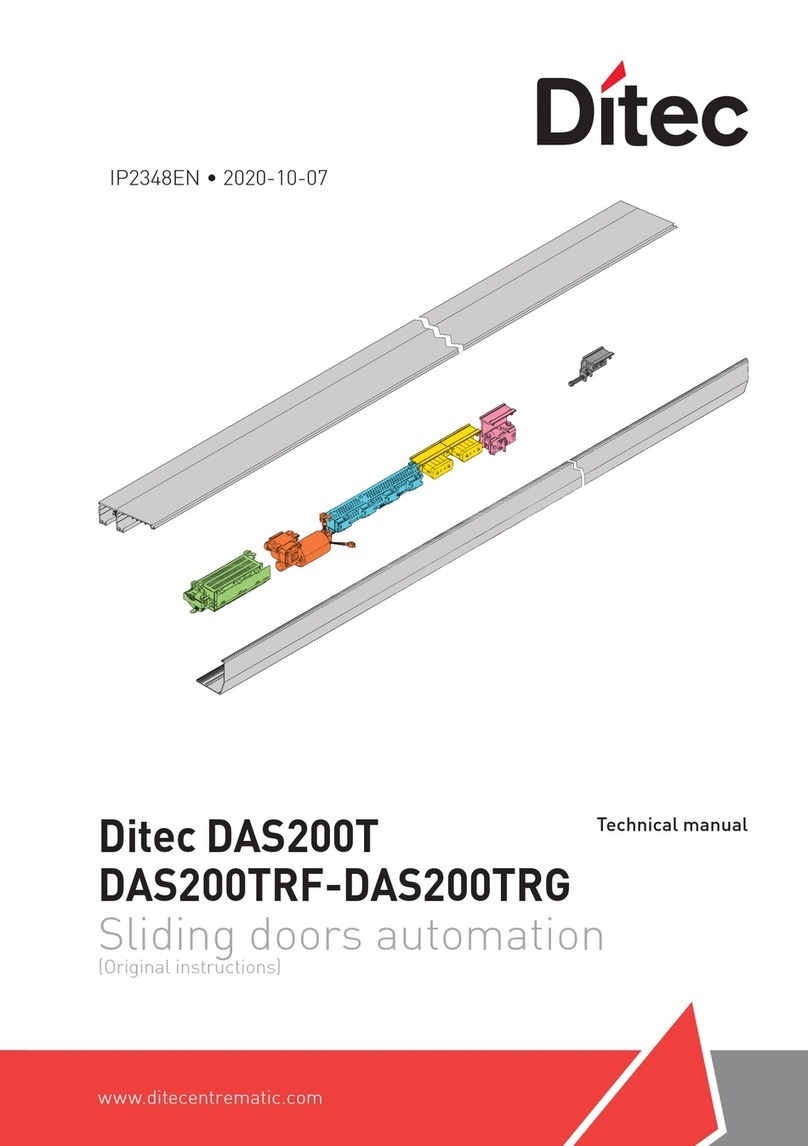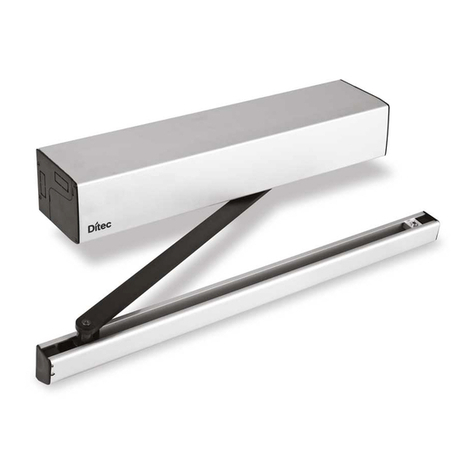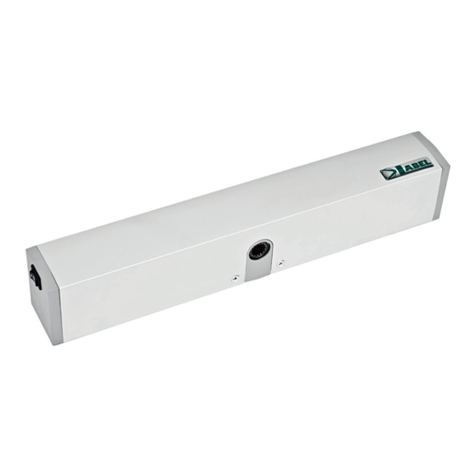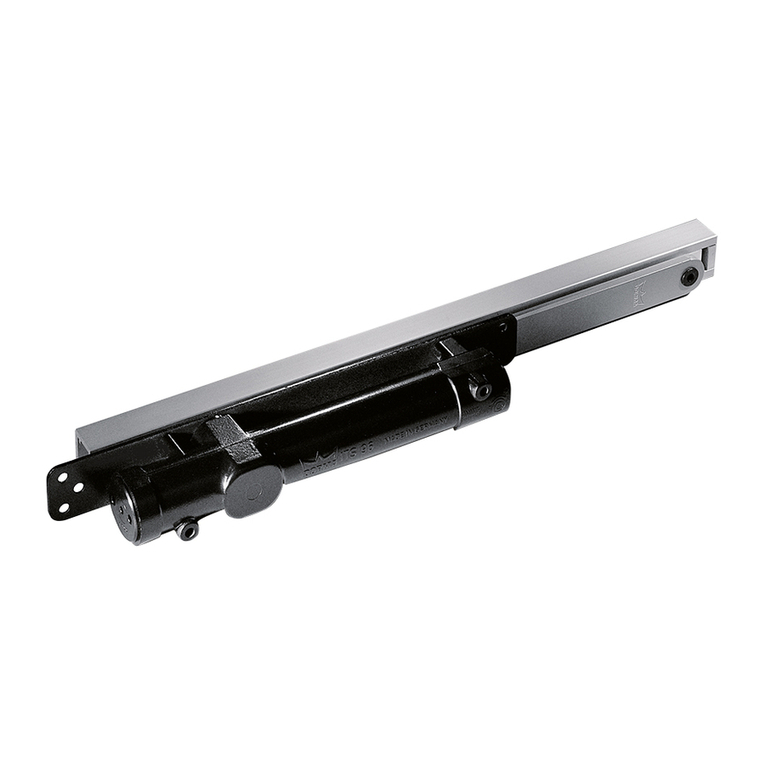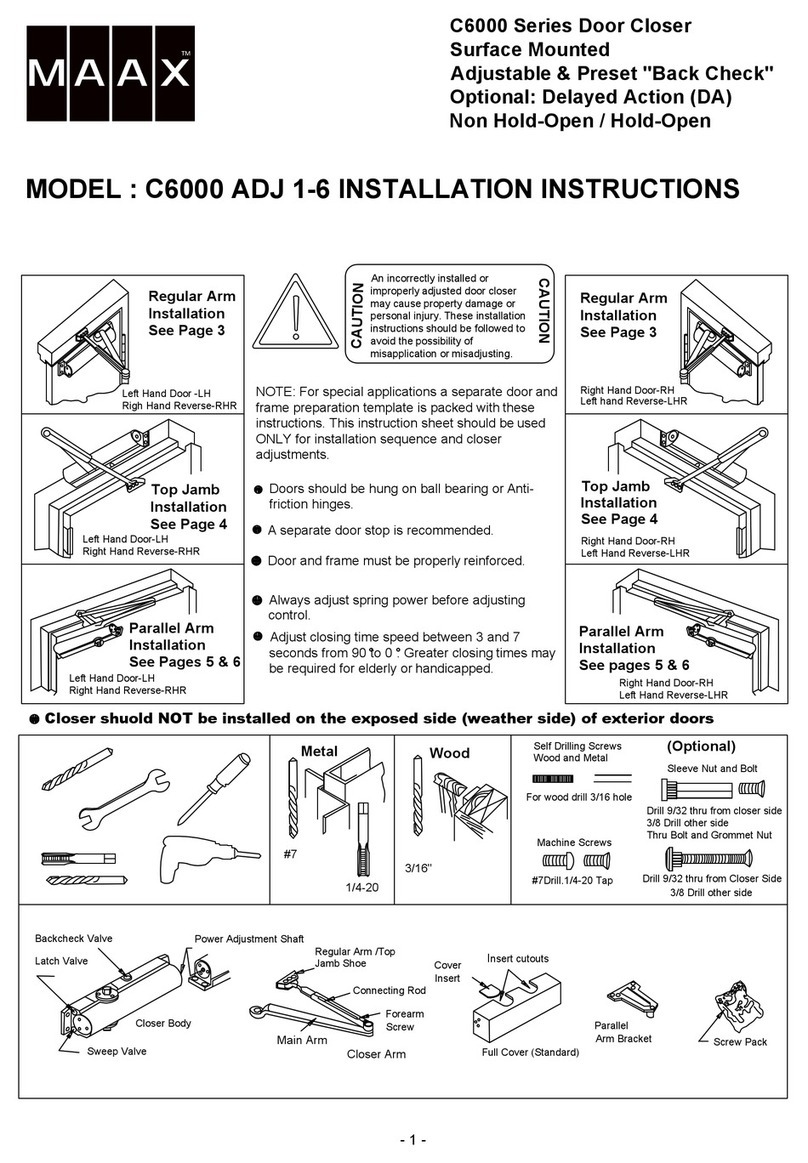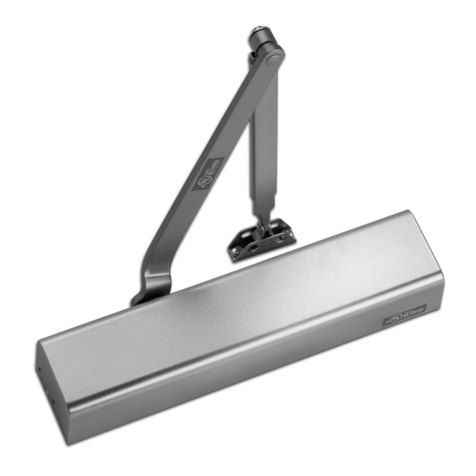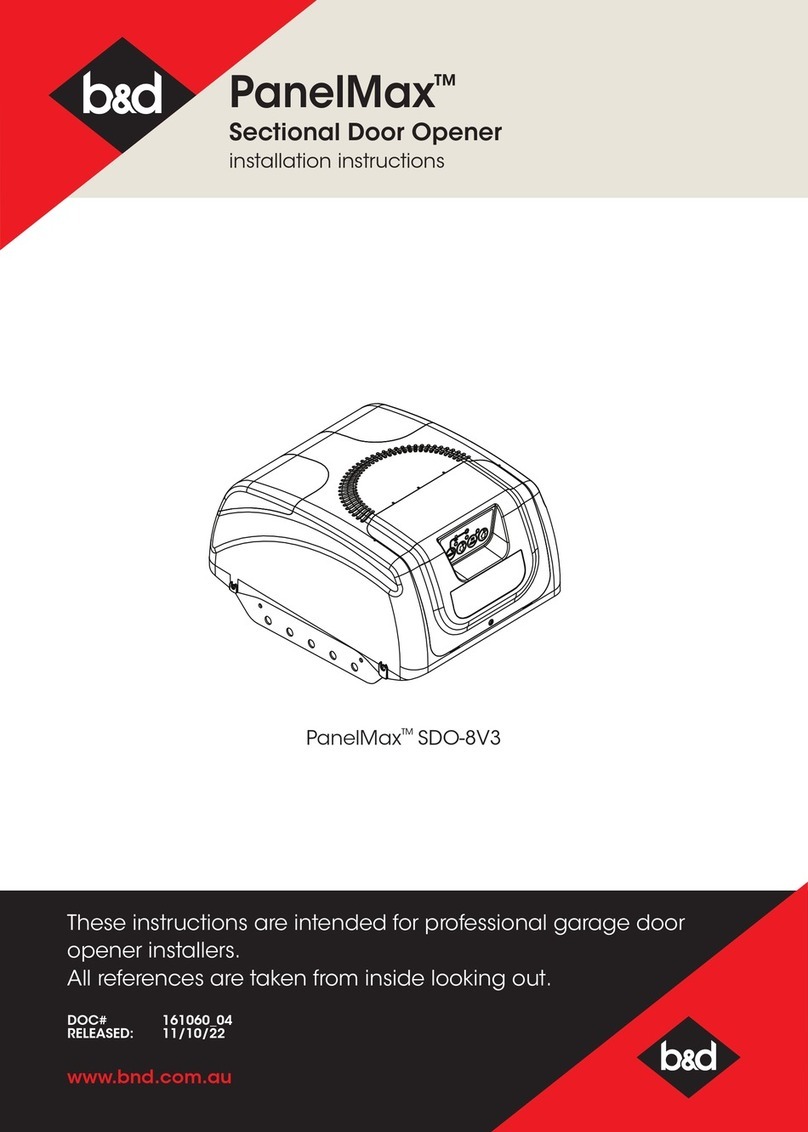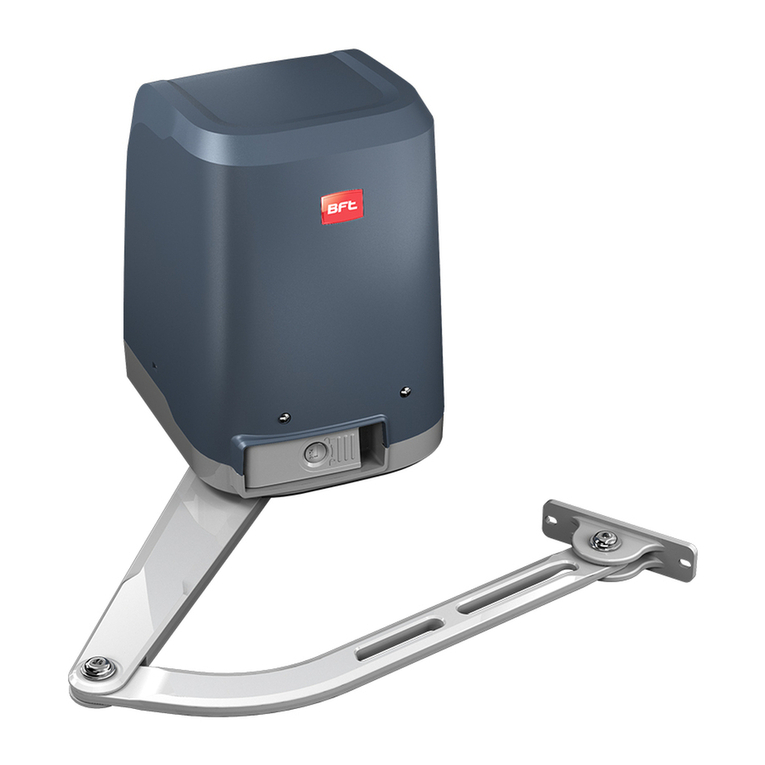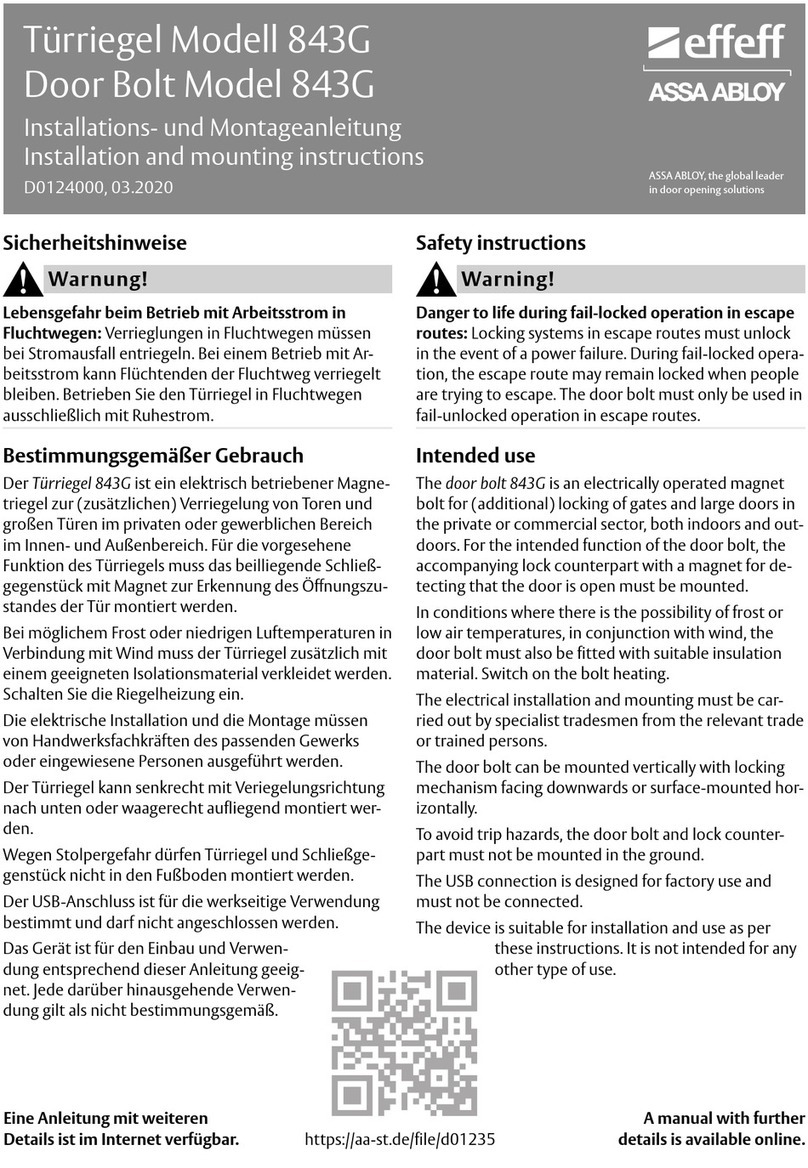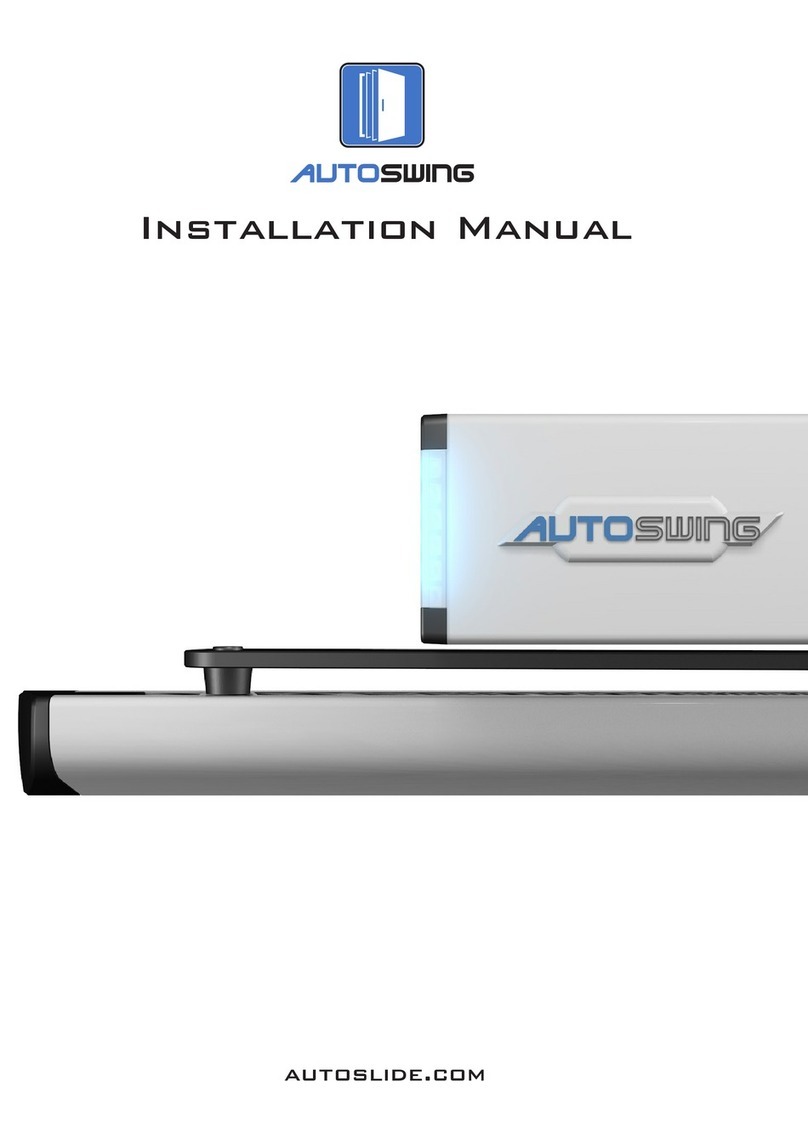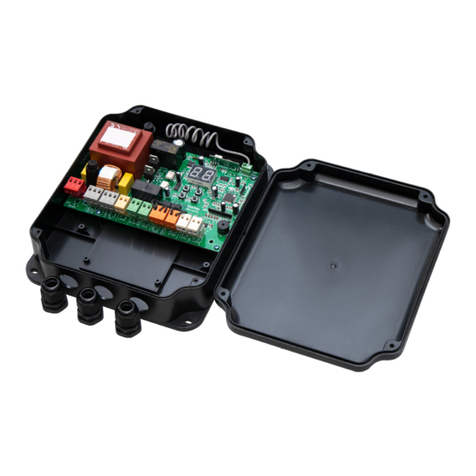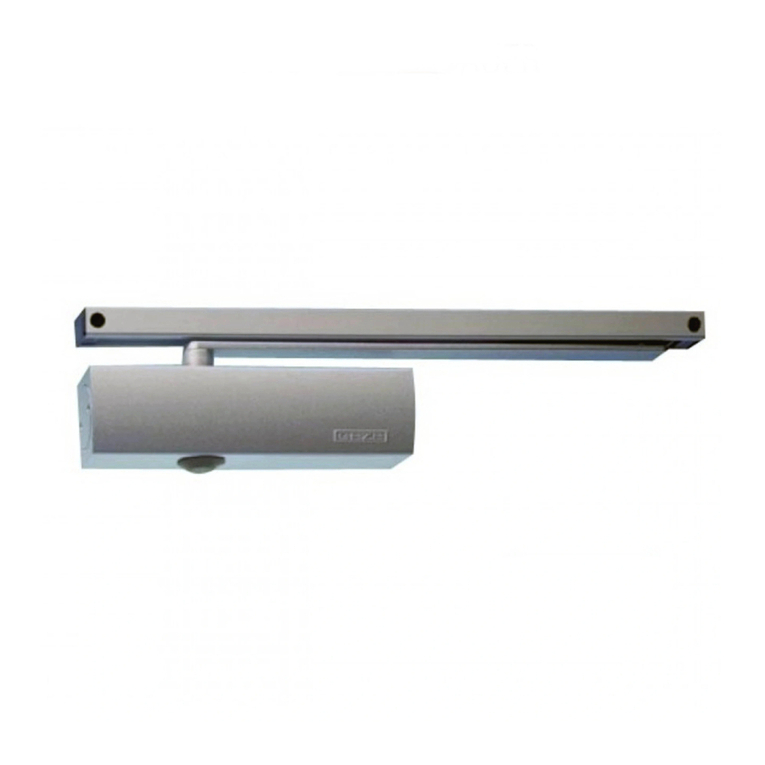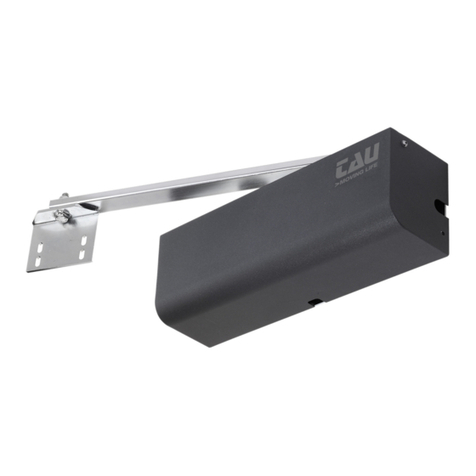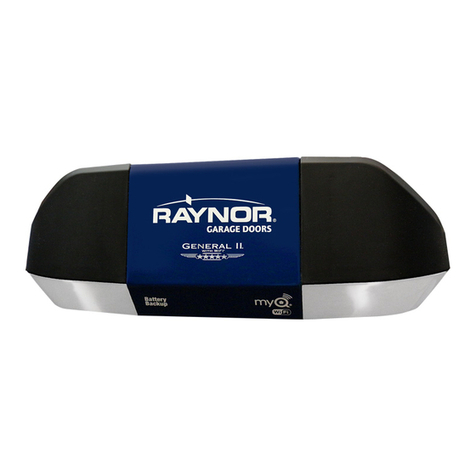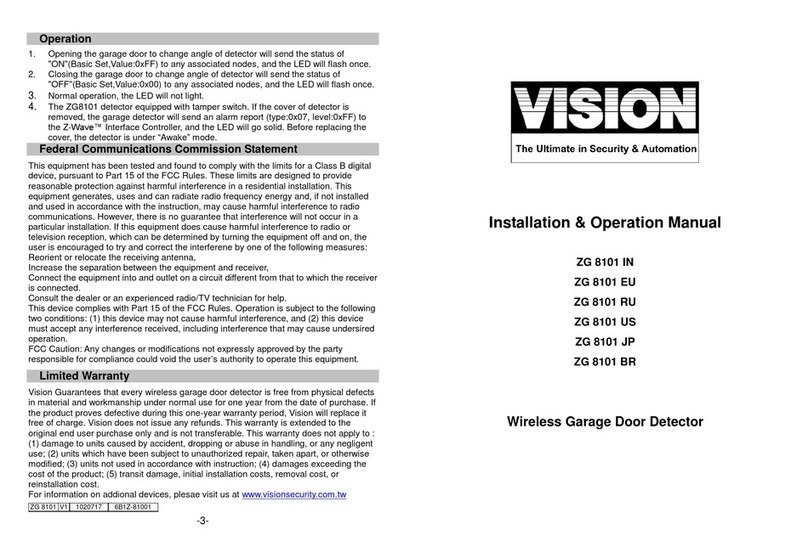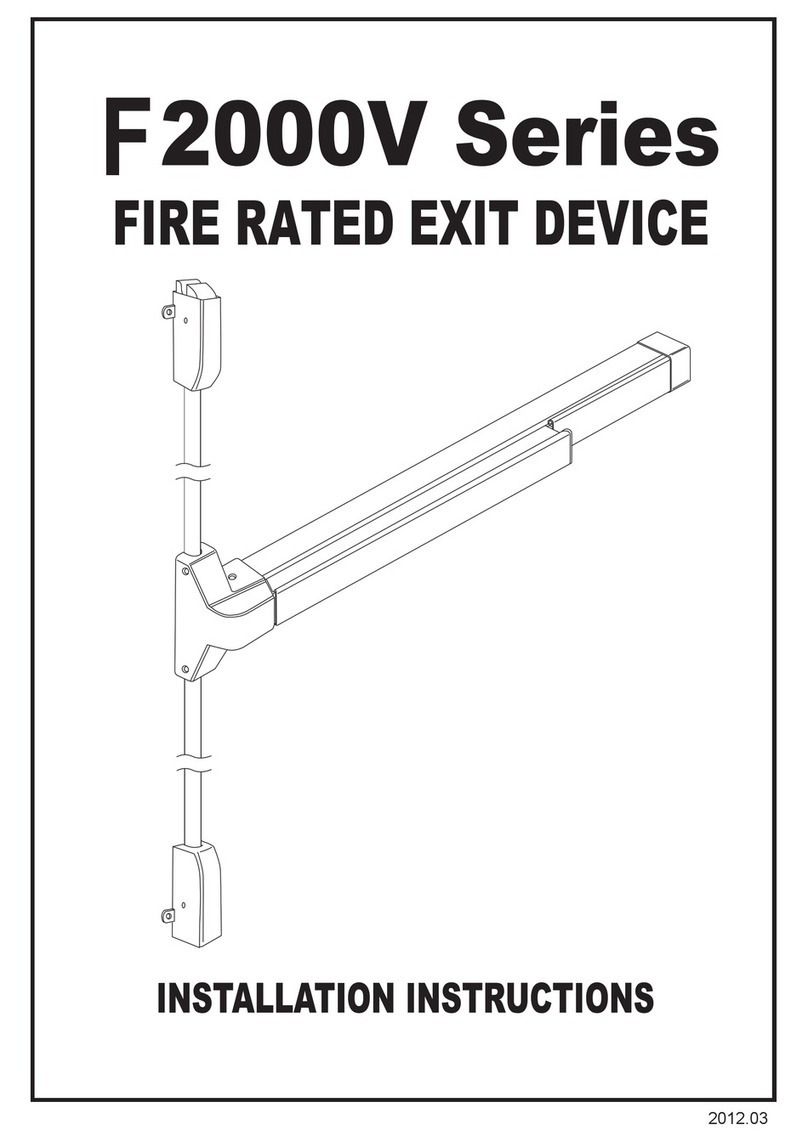DITEC BIS O Manual

DITEC S.p.A.
Via Mons. Banfi, 3 - 21042 Caronno Pertusella (VA) - ITALY
Tel. +39 02 963911 - Fax +39 02 9650314
www.ditec.it - [email protected]
Manuale di installazione
e manutenzione per porte
scorrevoli
Installation and mainte-
nance manual for sliding
door
Manuel d’installation et
d’entretien pour portes
coulissantes
Montage und Wartungs-
handbuch für Schiebetüren
Manual de instalaciòn y
manutenciòn para puertas
correderas
Instalação e Manutenção
para portas deslizantes
BIS
IP1653 - rev. 2007-07-11
I
GB
F
D
E
P

2
DITEC S.P.A - IP1653 - BIS
Fig. 1
Fig. 2

3DITEC S.P.A - IP1653 - BIS
BIS O
Fig. 3a
NOTE:
HM = H - 28
HVM = H - 9
HVF = H - 28 - Y
X = 10 mm / 12 mm

4
DITEC S.P.A - IP1653 - BIS
BIS V
Fig. 3b
NOTE:
HM = H - 28
HVM = H - 9
HVF = H - 28 - Y
X = 10 mm / 12 mm

5DITEC S.P.A - IP1653 - BIS
BIS T
Fig. 3c
NOTE:
HM = H - 32
HVM = H - 48
HVF = H - 77
X = 10 mm
(
(-
+0!-
+0!-
0"
")3!,4
(
(6&
(6-
+!-4
6306
6'
888
")3!#4
0"
!#
+!-4

6
DITEC S.P.A - IP1653 - BIS
/0%. /0%.
BIS 1 O-V DX
BIS 1 O-V SX
Fig. 4
Fig. 6
Fig. 7
/0%.
Fig. 5
BIS 2 O-V

7DITEC S.P.A - IP1653 - BIS
Fig. 13
BIS 1 T DX
BIS 1 T SX
BIS 2 T
Fig. 8
Fig. 9
Fig. 10
BIS 1 T DX
BIS 1 T SX
BIS 2 T
Fig. 11
Fig. 12
/0%.

8
DITEC S.P.A - IP1653 - BIS
IAVVERTENZE GENERALI PER LA SICUREZZA
Il presente manuale di installazione è rivolto esclusivamen-
te a personale professionalmente competente.
L’installazione, i collegamenti elettrici e le regolazioni
devono essere effettuati nell’osservanza della Buona Tecnica
e in ottemperanza alle norme vigenti.
Leggere attentamente le istruzioni prima di iniziare l’installazione
del prodotto.
Una errata installazione può essere fonte di pericolo. I materiali
dell’imballaggio (plastica, polistirolo, ecc.) non vanno dispersi
nell’ambiente e non devono essere lasciati alla portata dei
bambini in quanto potenziali fonti di pericolo.
Prima di iniziare l’installazione verificare l’integrità del prodotto.
Non installare il prodotto in ambiente e atmosfera esplosivi:
presenza di gas o fumi infiammabili costituiscono un grave
pericolo per la sicurezza.
Prima di installare la motorizzazione, apportare tutte le modifiche
strutturali relative alla realizzazione dei franchi di sicurezza ed
alla protezione o segregazione di tutte le zone di schiacciamen-
to, cesoiamento, convogliamento e di pericolo in genere.
Verificare che la struttura esistente abbia i necessari requisiti
di robustezza e stabilità. Il costruttore della motorizzazione non
è responsabile dell’inosservanza della Buona Tecnica nella co-
struzione degli infissi da motorizzare, nonché delle deformazioni
che dovessero intervenire nell’utilizzo. I dispositivi di sicurezza
(fotocellule, coste sensibili, stop di emergenza, ecc.) devono
essere installati tenendo in considerazione: le normative e le
direttive in vigore, i criteri della Buona Tecnica, l’ambiente di
installazione, la logica di funzionamento del sistema e le forze
sviluppate dalla porta o cancello motorizzati.
I dispositivi di sicurezza devono proteggere eventuali zone di
schiacciamento, cesoiamento, convogliamento e di pericolo in
genere, della porta o cancello motorizzati.
Applicare le segnalazioni previste dalle norme vigenti per indi-
viduare le zone pericolose.
Ogni installazione deve avere visibile l’indicazione dei dati iden-
tificativi della porta o cancello motorizzati.
Prima di collegare l’alimentazione elettrica accertarsi che i
dati di targa siano rispondenti a quelli della rete di distribu-
zione elettrica. Prevedere sulla rete di alimentazione un interrut-
tore/sezionatore onnipolare con distanza d’apertura dei contatti
uguale o superiore a 3 mm. Verificare che a monte dell’impianto
elettrico vi sia un interruttore differenziale e una protezione di
sovracorrente adeguati. Quando richiesto, collegare la porta o
cancello motorizzati ad un efficace impianto di messa a terra
eseguito come indicato dalle vigenti norme di sicurezza.
Durante gli interventi di installazione, manutenzione e ripara-
zione, togliere l’alimentazione prima di aprire il coperchio per
accedere alle parti elettriche.
La manipolazione delle parti elettroniche deve essere effet-
tuata munendosi di bracciali conduttivi antistatici collegati
a terra. Il costruttore della motorizzazione declina ogni respon-
sabilità qualora vengano installati componenti incompatibili ai
fini della sicurezza e del buon funzionamento.
Per l’eventuale riparazione o sostituzione dei prodotti dovranno
essere utilizzati esclusivamente ricambi originali.
L’installatore deve fornire tutte le informazioni relative al fun-
zionamento automatico, manuale e di emergenza della porta o
cancello motorizzati, e consegnare all’utilizzatore dell’impianto
le istruzioni d’uso.
IDIRETTIVA MACCHINE
Ai sensi della Direttiva Macchine (98/37/CE) l’installatore che
motorizza una porta o un cancello ha gli stessi obblighi del
costruttore di una macchina e come tale deve:
- predisporre il fascicolo tecnico che dovrà contenere i docu-
menti indicati nell’Allegato V della Direttiva Macchine;
(Il fascicolo tecnico deve essere conservato e tenuto a
disposizione delle autorità nazionali competenti per almeno
dieci anni a decorrere dalla data di costruzione della porta
motorizzata);
- redigere la dichiarazione CE di conformità secondo l’Allegato
II-A della Direttiva Macchine e consegnarla al cliente;
- apporre la marcatura CE sulla porta motorizzata ai sensi del
punto 1.7.3 dell’Allegato I della Direttiva Macchine.
Per maggiori informazioni consultare le “Linee guida per la
realizzazione del fascicolo tecnico” disponibile su internet al
seguente indirizzo: www.ditec.it
INDICAZIONI DI UTILIZZO
Peso massimo e peso consentito: vedi DATI TECNICI
Classe di servizio: 5 (minimo 5 anni di utilizzo con 600 cicli
al giorno)
Utilizzo: MOLTO INTENSO (per ingressi di tipo collettivo con
uso carraio o pedonale molto intenso)
- Le prestazioni di utilizzo si riferiscono al peso raccomandato
(circa 2/3 del peso massimo consentito). L’utilizzo con il peso
massimo consentito potrebbe ridurre le prestazioni sopra
indicate.
- La classe di servizio, i tempi di utilizzo e il numero di cicli
consecutivi hanno valore indicativo. Sono rilevati statistica-
mente in condizioni medie di utilizzo e non possono essere
certi per ogni singolo caso. Si riferiscono al periodo nel
quale il prodotto funziona senza necessità di manutenzione
straordinaria.
- Ogni ingresso automatico presenta elementi variabili quali:
attriti, bilanciature e condizioni ambientali che possono mo-
dificare in maniera sostanziale sia la durata che la qualità di
funzionamento dell’ingresso automatico o di parte dei suoi
componenti (fra i quali gli automatismi). E’ compito dell’in-
stallatore adottare coefficienti di sicurezza adeguati ad ogni
particolare installazione.
DICHIARAZIONE DEL FABBRICANTE
(Direttiva 98/37/CE, Allegato II, parte B)
Fabbricante: DITEC S.p.A.
Indirizzo: via Mons. Banfi, 3 - 21042 Caronno P.lla (VA)
ITALY
Dichiara che l’automazione per porte scorrevoli serie BIS
- è costruito per essere incorporato in una macchina o per
essere assemblato con altri macchinari per costituire una
macchina considerata dalla Direttiva 98/37/CE;
- è conforme alle condizioni delle seguenti altre direttive CE:
Direttiva compatibilità elettromagnetica 89/336/CEE;
Direttiva bassa tensione 73/23/CEE;
e inoltre dichiara che non è consentito mettere in servizio il
macchinario fino a che la macchina in cui sarà incorporata o
di cui diverrà componente sia stata identificata e ne sia stata
dichiarata la conformità alle condizioni della Direttiva 98/37/CE
e alla legislazione nazionale che la traspone.
Caronno Pertusella, 26-06-2000
Fermo Bressanini
(Presidente)

9DITEC S.P.A - IP1653 - BIS
I
2. RIFERIMENTI ILLUSTRAZIONI
La garanzia di funzionamento e le prestazioni dichiarate si otten-
gono solo con accessori e dispositivi di sicurezza DITEC.
2.1 RIFERIMENTI INSTALLAZIONE TIPO (fig. 1)
[1] Quadro elettrico
[2] Motoriduttore
[3] Radar
[4] Leva sblocco
[5] Fotocellule
[6] Selettore
[7] Trasformatore
[8] Collegare l’alimentazione ad un interruttore onnipolare
di tipo omologato con distanza d’apertura dei contatti di
almeno 3 mm (non di nostra fornitura) protetto contro
l’attivazione involontaria e non autorizzata.
Il collegamento alla rete deve avvenire su canala
indipendente e separata dai collegamenti ai dispositivi di
comando e sicurezza.
2.2 RIFERIMENTI AUTOMAZIONE (fig. 2)
[9] Fermi battuta
[10] Blocco
[11] Kit batterie
[12] Rinvio cinghia
[13] Cinghia
[14] Guida
[15] Testate
[16] Carter
[17] Scheda diramazione comandi (Dir)
3. INSTALLAZIONE
Tutte le misure riportate sono espresse in millimetri (mm), salvo
diversa indicazione.
3.1 FISSAGGIO GUIDA
In fig. 3 sono riportate le misure di fissaggio della guida [14] in
funzione dell’altezza dell’anta:
HM = altezza anta mobile intelaiata;
HVM = altezza vetro anta mobile;
HVF = altezza vetro anta fissa.
- Fissare la guida con tasselli d’acciaio M6 Ø12 oppure viti
6MA. Distribuire i punti di fissaggio ogni 800 mm circa.
- Verificare che il dorso della guida [14] risulti perpendico-
lare al pavimento e non deformato in senso longitudinale
dalla forma della parete. Se la parete non è dritta e liscia
bisogna predisporre delle piastre di ferro e su queste poi
fissare la guida.
I
1. DATI TECNICI
BIS 1 O-V BIS 2 O-V BIS 1 T BIS 2 T
Alimentazione 230 V~ / 50-60 Hz
Assorbimento 1 A
Alimentazione accessori 24 V= / 0,5 A (max)
Velocità in apertura
in chiusura
di acquisizione
0,8 m/s
0,8 m/s
0,1 m/s
1,6 m/s
1,6 m/s
0,2 m/s
0,8 m/s
0,8 m/s
0,1 m/s
1,6 m/s
1,6 m/s
0,2 m/s
Intermittenza S3=100%
Corsa massima 5000 mm
Portata massima 120 kg 200 kg 180 kg 260 kg
Portata ruote rinforzate 150 kg 250 kg - -
Temperatura -20° C / +55° C (Batterie +5° C / +40° C)
Grado di protezione IP20
ATTENZIONE: Il fissaggio della guida alla parete deve
essere sicuro e adeguato al peso delle ante.
3.2 PREPARAZIONE DELL’ANTA INTELAIATA
L’anta deve essere di costruzione robusta ed i vetri incollati
almeno agli angoli. Il traverso superiore deve essere rinforzato
all’interno con un profilo di ferro dove avvitare in più punti il profilo
di attacco anta. Per ante alte e strette, il rinforzo in ferro deve
proseguire per parte dei montanti verticali.
E’ opportuno installare alle estremità dell’anta dei bordi in gomma
per ridurre le forze d’urto.
3.3 PREPARAZIONE DELL’ANTA IN CRISTALLO
(Fig. 4) Il profilo di attacco cristallo AC1356 si può usare con
ante in solo cristallo di spessore 10 o 12 mm.
Non è utilizzabile con nessun altro tipo di vetro normale o ac-
coppiato.
Il fissaggio prevede fori passanti Ø10 sul profilo di alluminio e
Ø15 sul vetro. Il numero di fori ed il rispettivo interasse sono in
funzione della larghezza dell’anta. E’ consigliabile inserire del
silicone tra lo spigolo del vetro e il fondo interno del profilo.
Riferimenti anta in cristallo
[C] Rondella quadra
[D] Vite M6 TPS
[E] Quadro filettato
[F] Boccola in nylon per cristallo 10 mm
[G] Boccola in nylon per cristallo 12 mm
3.4 INSTALLAZIONE E REGOLAZIONE DELL’ANTA
- Montare l’anta al gruppo ruote con le viti [J]. La ruota
esterna del carrello non deve sporgere oltre la dimen-
sione dell’anta.
- Regolare la posizione orizzontale dell’anta rispettando
le misure indicate in fig. 5, 6, 7, 8, 9 e 10 e fissare la
regolazione con le viti [J].
- Allentare le viti [K], regolare la posizione verticale dell’anta
mediante la vite [M] e fissare la regolazione con le viti
[K].
N.B.: Verificare, muovendo l’anta a mano, che il movimento sia
libero e senza attriti e che tutte le ruote appoggino sulla guida,
eventualmente allentare le viti [J] e [K], assestare i carrelli sulla
guida e rifissare le viti.

10
DITEC S.P.A - IP1653 - BIS
I
Attenzione: Tra ante in solo cristallo, senza guarnizioni, lasciare
almeno 10 mm in posizione di chiusura per evitare il contatto
tra i cristalli.
3.5 INSTALLAZIONE GUIDE A PAVIMENTO
Le guide a pavimento devono essere di materiale antifrizione
come PVC, NYLON, TEFLON. E’ preferibile che la lunghezza
della guida non sia maggiore del sormonto tra anta mo-
bile e fisso, e che non entri nel vano passaggio. La gola
di scorrimento della guida a pavimento deve essere liscia
per tutta la lunghezza dell’anta.
(KP515AB) Guida per anta intelaiata di nostra fornitura: ridurre
del necessario.
(KP369) Guida per anta in cristallo di nostra fornitura.
KP515AB KP369
I
3.6 TENSIONE DELLA CINGHIA
- Allentare le viti [F] ed avvitare [G] fino alla massima esten-
sione della molla.
- Allentare le viti che fissano il gruppo rinvio alla guida.
- Tirare manualmente tutto il gruppo rinvio verso sinistra e
fissarlo alla guida.
- Svitare la vite [G] fino a portare la molla alla compressione
di 22 mm per lunghezza cassonetto (LT) <2600 oppure 20
mm per lunghezza cassonetto (LT) ≥2600.
- Bloccare la regolazione con le viti [F].
3.7 INSTALLAZIONE DISPOSITIVO DI BLOCCO
- Portare le ante in posizione di chiusura.
- Fissare il dispositivo di blocco alla guida.
- Centrare l’incontro fra [N] e la staffa scontro blocco [P]
e verificare manualmente il corretto funzionamento del
dispositivo di blocco.
- Lubrificare leggermente il piolo [N] e la parte inclinata della
staffa [P].
BIS O BIS V
BIS T

11 DITEC S.P.A - IP1653 - BIS
II
Tutti i diritti sono riservati
I dati riportati sono stati redatti e controllati con la massima
cura. Tuttavia non possiamo assumerci alcuna responsabilità
per eventuali errori, omissioni o approssimazioni dovute ad
esigenze tecniche o grafiche.
3.8 DISPOSIZIONE TIRANTI BIS T
BIS 1 T apertura a destra (fig. 11)
BIS 1 T apertura a sinistra (fig. 12)
BIS 2 T (fig. 13)
Per regolare la tensione dei cavi avvitare o svitare i tiranti [R]
ed [S] in egual misura.
Per regolare il sormonto delle ante operare come segue:
- Portare le ante in battuta in posizione di chiusura.
- Trattenere ben ferma in posizione di battuta l’anta esterna
[T].
- Allentando [R] e tirando [S], l’anta [U] si sposta verso [S] (il
sormonto aumenta).
- Allentando [S] e tirando [R], l’anta [U] si sposta verso [R] (il
sormonto diminuisce)
4. COLLEGAMENTI ELETTRICI
I collegamenti elettrici e l’avviamento sono illustrati nel manuale
di installazione del Quadro Elettrico EL16.
5. PIANO DI MANUTENZIONE (ogni 6 mesi).
Senza alimentazione 230 V~ e batterie:
- Pulire le parti in movimento (le guide di scorrimento dei carrelli
e le guide di scorrimento a terra).
- Controllare la tensione della cinghia.
- Pulire sensori e fotocellule
- Controllare la stabilità dell’automatismo e verificare il serraggio
di tutte le viti.
- Verificare il corretto allineamento delle ante, la posizione delle
battute e il corretto inserimento del blocco.
Ridare alimentazione 230 V~ e batterie:
- Controllare il corretto funzionamento del sistema di blocco.
- Controllare la stabilità della porta e che il movimento sia re-
golare e senza attriti.
- Controllare il corretto funzionamento di tutte le funzioni di
comando.
- Controllare il corretto funzionamento delle fotocellule.
- Verificare che le forze sviluppate dalla porta rispettino i requisiti
indicati dalle norme vigenti.
ATTENZIONE: per le parti di ricambio fare riferimento al listino
ricambi.

FUNZIONI SELETTORI ComH-K / Com E
PORTA CHIUSA
APERTURA TOT. BIDIREZIONALE
APERTURA TOT. MONODIREZIONALE
STOP
PORTA APERTA
APERTURA PARZIALE
DITEC S.p.A.
Via Mons. Banfi, 3
21042 Caronno Pertusella (VA) - ITALY
Tel. +39 02 963911 - Fax +39 02 9650314
www.ditec.it - [email protected]
Installatore:
DA STACCARE E CONSEGNARE ALL’UTILIZZATORE
I
OPERAZIONE DI SBLOCCO
Nei casi di manutenzione, malfunzionamento, o di emergenza,
abbassare la leva di sblocco e spostare manualmente le ante
in posizione di apertura.
OPERAZIONE DI BLOCCO
Per ribloccare, riportare la leva di sblocco nella posizione
iniziale.
Attenzione: Eseguire le operazioni di blocco e sblocco ante a
motore fermo.
La posizione di STOP non consente alle batterie di intervenire
in caso di emergenza.
N.B.: Per consentire un corretto funzionamento della porta e
la costante ricarica delle batterie, l’automazione deve essere
sempre alimentata e con le batterie collegate (anche di notte).
AVVERTENZE GENERALI PER LA SICUREZZA
Le presenti avvertenze sono parte integrante ed essenziale
del prodotto e devono essere consegnate all’utilizzatore.
Leggerle attentamente in quanto forniscono importanti indicazio-
ni riguardanti la sicurezza di installazione, uso e manutenzione.
È necessario conservare queste istruzioni e trasmetterle ad
eventuali subentranti nell’uso dell’impianto.
Questo prodotto dovrà essere destinato solo all’uso per il quale
è stato espressamente concepito. Ogni altro uso è da consi-
derarsi improprio e quindi pericoloso. Il costruttore non può
essere considerato responsabile per eventuali danni causati
da usi impropri, erronei ed irragionevoli. Evitare di operare in
prossimità delle cerniere o organi meccanici in movimento. Non
entrare nel raggio di azione della porta o cancello motorizzati
mentre è in movimento.
Non opporsi al moto della porta o cancello motorizzati poiché
può causare situazioni di pericolo. Non permettere ai bambini di
giocare o sostare nel raggio di azione della porta o cancello mo-
torizzati. Tenere fuori dalla portata dei bambini i radiocomandi e/o
qualsiasi altro dispositivo di comando, per evitare che la porta o
cancello motorizzati possa essere azionata involontariamente.
In caso di guasto o di cattivo funzionamento del prodotto, disin-
serire l’interruttore di alimentazione, astenendosi da qualsiasi
tentativo di riparazione o di intervento diretto e rivolgersi solo a
personale professionalmente competente.
Il mancato rispetto di quanto sopra può creare situazioni di
pericolo.
Qualsiasi intervento di pulizia, manutenzione o riparazione, deve
essere effettuato da personale professionalmente competente.
Per garantire l’efficienza dell’impianto ed il suo corretto funziona-
mento è indispensabile attenersi alle indicazioni del costruttore
facendo effettuare da personale professionalmente competente
la manutenzione periodica della porta o cancello motorizzati.
In particolare si raccomanda la verifica periodica del corretto
funzionamento di tutti i dispositivi di sicurezza. Gli interventi
di installazione, manutenzione e riparazione devono essere
documentati e tenuti a disposizione dell’utilizzatore.
ISTRUZIONI D’USO AUTOMAZIONE PER PORTE SCORREVOLI BIS
I

13 DITEC S.P.A - IP1653 - BISDITEC S.P.A - IP1653 - BIS
GB
GENERAL SAFETY PRECAUTIONS
This installation manual is intended for professionally
competent personnel only.
Installation, electrical connections and adjustments must
be performed in accordance with Good Working Methods and
in compliance with applicable regulations.
Before installing the product, carefully read the instructions. Bad
installation could be hazardous.
The packaging materials (plastic, polystyrene, etc.) should not
be discarded in the environment or left within reach of children,
as these are a potential source of hazard.
Before installing the product, make sure it is in perfect condi-
tion.
Do not install the product in an explosive environment and atmos-
phere: gas or inflammable fumes are a serious hazard risk.
Before installing the motors, make all structural changes relating
to safety clearances and protection or segregation of all areas
where there is risk of being crushed, cut or dragged, and danger
areas in general.
Make sure the existing structure is up to standard in terms of
strength and stability.
The motor manufacturer is not responsible for failure to use
Good Working Methods in building the frames to be motorised
or for any deformation occurring during use.
The safety devices (photocells, safety edges, emergency stops,
etc.) must be installed taking into account: applicable laws and
directives, Good Working Methods, installation premises, sys-
tem operating logic and the forces developed by the motorised
door or gate.
The safety devices must protect any areas where the risk exists
of being crushed, cut or gragged, or where there are any other
risks generated by the motorised door or gate. Apply hazard
area notices required by applicable regulations.
Each installation must clearly show the identification details of
the motorised door or gate.
Before making power connections, make sure the plate
details correspond to those of the power mains.
Fit an omnipolar disconnection switch with a contact opening
gap of at least 3 mm. Make sure an adequate residual current
circuit breaker and overcurrent cutout are fitted upstream of the
electrical system.
When necessary, connect the motorised door or gate to a reli-
able earth system made in accordance with applicable safety
regulations. During installation, maintenance and repair, interrupt
the power supply before opening the lid to access the electrical
parts.
To handle electronic parts, w ear earthed antistatic conduc-
tive bracelets.
The motor manufacturer declines all responsibility in the event
of component parts being fitted that are not compatible with the
safe an correct operation.
For repairs or replacements of products only original spare parts
must be used.
The installer shall provide all information relating to automatic,
manual and emergency operation of the motorised door or gate,
and provide the user with operating instructions.
MACHINERY DIRECTIVE
Pursuant to Machinery Directive (98/37/EC) the installer who
motorises a door or gate has the same obligations as the ma-
nufacturer of machinery and as such must:
- prepare the technical file which must contain the documents
indicated in Annex V of the Machinery Directive;
GB
(The technical file must be kept and placed at the disposal of
competent national authorities for at least ten years from the
date of manufacture of the motorised door);
- draft the EC declaration of conformity in accordance with
Annex II-A of the Machinery Directive and deliver it to the
customer;
- affix the CE marking on the power operated door in accordance
with point 1.7.3 of Annex I of the Machinery Directive.
For more information consult the “Technical Manual Guidelines”
available on Internet at the following address: www.ditec.it
APPLICATIONS
Maximum permissible weight and recommended weight:
see TECHNICAL DATA
Service life: 5 (minimum 5 years of working life with 600 cycles
a day)
Applications: HEAVY DUTY (For vehicle or pedestrian ac-
cesses to institutional complexes with very intense use).
- Performance characteristics are to be understood as refer-
ring to the recommended weight (approx. 2/3 of maximum
permissible weight). A reduction in performance is to be ex-
pected when the access is made to operate at the maximum
permissible weight.
- Service class, running times, and the number of consecu-
tive cycles are to be taken as merely indicative having been
statistically determined under average operating conditions,
and are therefore not necessarily applicable to specific condi-
tions of use. During given time spans product performance
characteristics will be such as not to require any special
maintenance.
- The actual performance characteristics of each automatic
access may be affected by independent variables such as
friction, balancing and environmental factors, all of which
may substantially alter the performance characteristics of the
automatic access or curtail its working life or parts thereof
(including the automatic devices themselves). When setting
up, specific local conditions must be duly borne in mind and
the installation adapted accordingly for ensuring maximum
durability and trouble-free operation.
DECLARATION BY THE MANUFACTURER
(Directive 98/37/EC, Annex II, sub B)
Manufacturer: DITEC S.p.A.
Address: via Mons. Banfi, 3-21042 Caronno P.lla
(VA) - ITALY
Herewith declares that the electromechanical automatic system
for sliding doors series BIS
- is intended to be incorpored into machinery or to be assem-
bled with other machinery to constitute machinery convered
by Directive 98/37/EC;
- is in conformity with the provisions of the following other EEC
directives:
Electromagnetic Compatibility Directive 89/336/EEC;
Low Voltage Directive 73/23/EEC;
and furthermore declares that it is not allowed to put the ma-
chinery into service until the machinery into which it is to be
incorporated or of which it is to be a component has been found
and declared to be in conformity with the provisions of Directive
98/37/EC and with national implementing legislation.
Caronno Pertusella, 26-06-2000
Fermo Bressanini
(Chairman)

14
DITEC S.P.A - IP1653 - BIS
GB 1. TECHNICAL DATA
2. REFERENCE TO ILLUSTRATIONS
The given operating and performance features can only be guar-
anteed with the use of DITEC accessories and safety devices.
2.1 STANDARD INSTALLATION REFERENCES (fig. 1)
[1] Electrical Board
[2] Geared motor
[3] Radar
[4] Release
[5] Photocells
[6] Selector
[7] Transformer
[8] Connect power supply to a type-approved omnipolar
switch with a contact opening gap of no less that 3
mm (not supplied by us) protected against accidental and
unauthorized activation. Connection to supply mains must
be carried out in an independent raceway separate from
control connections and safety device connections.
2.2 AUTOMATION REFERENCES (fig. 2)
[9] Opening/Closing stops
[10] Lock
[11] Batteries kit
[12] Transmission unit
[13] Belt
[14] Guide
[15] Housing heads
[16] Cover
[17] Expanding connecting board (Dir)
3. INSTALLATION
Unless otherwise specified, all measurements are expressed
in millimetres (mm)
3.1 FIXING GUIDE
Fig. 3 shows the fastening of the guide [14] in accordance with
the height of the wing:
HM = height of framed mobile wing;
HVM = height of glass on mobile wing;
HVF = height of glass on fixed wing.
- Fasten guide by means of steel blocks M6 Ø12 or screws
6MA. The point of fixing shall be set on the guide around
every 800 mm.
- Verify if guide [14] rear side is perpendicular to the floor
and not lengthwise deformed by the shape of wall. Should
the wall not be straight and smooth, iron plates shall be
arranged on it prior to guide fastening.
BIS 1 O-V BIS 2 O-V BIS 1 T BIS 2 T
Power supply 230 V~ / 50-60 Hz
Absorption 1 A
Accessories power supply 24 V= / 0,5 A (max)
Opening speed (max.)
Closing speed (max.)
Acquisition speed (max.)
0,8 m/s
0,8 m/s
0,1 m/s
1,6 m/s
1,6 m/s
0,2 m/s
0,8 m/s
0,8 m/s
0,1 m/s
1,6 m/s
1,6 m/s
0,2 m/s
Intermittence S3=100%
Max. door run 5000 mm
Max. door weight 120 kg 200 kg 180 kg 260 kg
Weight (reinforced wheels) 150 kg 250 kg - -
Temperature -20° C / +55° C (Batteries +5° C / +40° C)
Degree of protection IP20
WARNING: the housing must be attached securely to the
wall to support the weight of the wings.
3.2 FRAMED DOOR WING PREPARATION
The door must be robustly constructed and its glasses must
be glued at least at the corners. The upper transom must be
reinforced on the inside with an iron profile on which the su-
spension profile must be screwed on several points. For tall,
narrow wings, the steel reinforcement must extend over part of
the vertical uprights. It is advisable to install rubber borders at
the ends of the wing to reduce force of impact.
3.3 Glass DOOR PREPARATION
(Fig. 4) The AC1356 glass fitting section may be used with glass-
only wings of 10 or 12 mm thickness.
It is not usable on any kind of normal or stratified glass.
The blocking operation is to be carried out through holes Ø 10,
present on aluminium profile, and holes Ø 15, present on the
glass. Number of holes and relative distance between centres
depend on door wing width. We recommend to apply a light layer
of silicone between the glass corner and the end of the profile.
Glass door wing references
[C] Square washer
[D] Screw M6 TPS
[E] Threaded panel
[F] Nylon bush for 10 mm glass
[G] Nylon bush for 12 mm glass
3.4 DOOR WING INSTALLATION AND ADJUSTMENT
- Mount the door wing to the wheel unit by means of screws
[J]. The roller shall remain within the width of the door.
- Adjust the horizontal position of the wing respecting the
measurements shown in figs 5, 6, 7, 8, 9 and 10 and set
the adjustment with screws [J].
- Loosen screws [K], adjust the vertical position of the wing
with screw [M] and set the adjustment with screws [K].
NOTE: Check, by moving the wing by hand, that it moves freely
and without friction and that all the wheels bear on the guide.
If necessary loosen the screws [J] and [K], adjust the carriages
onto the guide and tighten the screws.

15 DITEC S.P.A - IP1653 - BIS
GB
Warning: in closing position for all-glass wings, without
gaskets, leave at least 10 mm to avoid contact between
glass wings.
3.5 GUIDES AT FLOOR INSTALLATION
For guides at floor use only antifriction materials such as PVC,
NYLON, TEFLON. It is preferable that the length of the guide
should not be greater than the overlap between the mobile and
fixed wing, and that it not enter the passage space. The guide
slide on the floor must be smooth for the entire length of the
wing.
(KP515AB) Guide for framed door supplied by us: cut to re-
quired.
(KP369) Guide for glass door supplied by us.
BIS O
BIS V
BIS T
KP515AB KP369
3.6 BELT TIGHTNESS
- Loosen screws [F] and tighten screw [G] until maximum
extension of the spring.
- Loosen the screws that attach the return unit to the
guide.
- Pull the belt and return pulley until tight, then secure to the
profile.
- Loosen screw [G] until the spring has reached a compres-
sion of 22 mm for transom length (LT) <2600 or 20 mm for
cover length (LT) ≥2600.
- Lock the setting with screws [F].
3.7 INSTALLATION OF LOCKING DEVICE
- Put the wings in closed position.
- Secure the lock to the profile.
- Center the point of contact between [N] and locking bracket
[P] and manually check the correct operation of the locking
device.
- Lightly lubricate pin [N] and the slanted part of bracket
[P].

16
DITEC S.P.A - IP1653 - BIS
GB 3.8 BIS T TIE ROD POSITION
BIS 1 T right opening (fig. 11)
BIS 1 T left opening (fig. 12)
BIS 2 T (fig. 13)
To adjust cable tension, tighten or loosen rods [R] and [S] in
equal measure.
Adjust the overlap of the wing as follows:
- Bring door wings in closing position.
- The external door [T] wing must be in the stop position.
- Loosening [R] and pulling [S], the door wing [U] moves
towards [S] (overlap increases).
- Loosening [S] and pulling [R] , the door wing [U] moves
towards [R] (overlap decreases).
4. ELECTRICAL CONNECTION
Electrical wiring and starting are shown in the installation manual
of Control Panel EL16.
5. MAINTENANCE PROGRAM (each 6 month)
Power off 230 V~ and batteries:
- Clean and lubricate the moving components (especially
the inside edges of the guide along which the carriages
run).
- Check the tension of the belt.
- Clean sensors and photocells.
- Check for the stability of the automatism and check that all
the screws are tightened all the way.
- Check that the wings are correctly aligned, that stops are
properly positioned and that the lock has been correctly
fitted.
Power on 230 V~ and batteries:
- Check that the lock/release system is working properly.
- Check for the stability of the door and that the movement is
steady, without friction.
- Check the operation of all command functions.
- Check the functioning of the photocells.
- Check that the forces generated by the door comply with
legal requirements.
ATTENTION: For spare parts, see the spares price list.
All right reserved
All data and specifications have been drawn up and checked
with the greatest care. The manufacturer cannot however take
any responsibility for eventual errors, ommisions or incomplete
data due to technical or illustrative purposes.

SELECTORS FUNCTIONS ComH-K / Com E
CLOSED DOOR
TOTAL TWO-WAY OPENING
TOTAL ONE-WAY OPENING
STOP
OPENED DOOR
PARTIAL OPENING
RELEASE INSTRUCTION
In case of maintenance, malfunction, or emergency, lower relea-
se lever and manually move the wings to open position.
LOCK INSTRUCTION
To relock, return release lever to its previous position.
Attention: Perform the lock and release operations with the
motor stopped.
STOP position prevents the batteries from engaging in case of
emergency.
Note: For correct door operation and regular battery recharging,
it is essential that the automatic system be always powered with
batteries connected (also during the night).
GENERAL SAFETY PRECAUTIONS
The following precautions are an integral and essential part
of the product and must be supplied to the user.
Read them carefully as they contain important indications
for the safe installation, use and maintenace.
These instruction must be kept and forwarded to all possible
future user of the system.
This product must be used only for that which it has been ex-
pressely designed.
Any other use is to be considered improper and therefore dan-
gerous.
The manufacturer cannot be held responsible for possible da-
mage caused by improper, erroneous or unresonable use.
Avoid operating in the proximity of the hinges or moving mecha-
nical parts.
Do not enter the field of action of the motorised door or gate
while in motion.
Do not obstruct the motion of the motorised door or gate as this
may cause a situation of danger.
Do not lean against or hang on to the barrier when it is moving.
Do not allow children to play or stay within the field of action of
the motorised door or gate.
Keep remote control or any other control devices out of the reach
of children, in order to avoid possible involuntary activation of the
motorised door or gate. In case of breack down or malfunctioning
of the product, disconnect from mains, do not attempt to repair
or intervene directly and contact only qualified personnel.
Failure to comply with the above may create a situation of
danger.
All cleaning, maintenance or repair work must be carried out by
qualified personnel.
In order to guarantee that the system works efficiently and
correctly it is indispensable to comply with the manufacturer’s
indications thus having the periodic maintenance of the motori-
sed door or gate carried out by qualified personnel.
In particular regular checks are recommended in order to verify
that the safety devices are operating correctly. All installation,
maintenance and repair work must be documented and made
available to the user.
DITEC S.p.A.
Via Mons. Banfi, 3
21042 Caronno Pertusella (VA) - ITALY
Tel. +39 02 963911 - Fax +39 02 9650314
www.ditec.it - [email protected]
Installer:
TEAR OFF AND DELIVER TO USER
IGB
OPERATING INSTRUCTION FOR BIS SLIDING DOORS AUTOMATION

18
DITEC S.P.A - IP1653 - BIS
FCONSIGNES GENERALES DE SECURITE
Le présent manuel d’installation s’adresse exclusivement
à un personnel qualifié.
L’installation, les branchements électriques et les réglages
doivent être effectués conformément à la bonne pratique et aux
normes en vigueur. Lire attentivement les instructions avant de
commencer l’installation du produit. Une mauvaise installation
peut être source de danger. Ne pas jeter dans la nature les
matériaux qui composent l’emballage (plastique, polystyrène,
etc.) et ne pas les laisser à la portée des enfants car ils sont une
source potentielle de danger. Avant de commencer l’installation,
vérifier l’intégrité du produit.
Ne pas installer le produit en atmosphère et environnement
explosifs: la présence de gaz ou de fumées inflammables
constitue un grave danger pour la sécurité. Avant d’installer
la motorisation, apporter toutes les modifications structurelles
relatives à la réalisation des distances minimales de sécurité et
à la protection ou séparation de toutes les zones d’écrasement,
cisaillement, entraînement et de danger en général.
Vérifier que la structure existante remplit les prescriptions de
robustesse et stabilité.
Le fabricant de la motorisation décline toute responsabilité quant
à l’inobservation de la bonne pratique dans la construction des
portes et portails à motoriser, et aux déformations qui pourraient
se produire au cours de l’utilisation.
Les dispositifs de sécurité (cellules photoélectriques, bourrelets
sensibles, arrêt d’urgence, etc.) doivent être installés en tenant
compte : des réglementations et directives en vigueur, des
règles de la bonne pratique, de l’environnement d’installation,
de la logique de fonctionnement du système et des forces
développées par la porte ou le portail motorisé. Les dispositifs
de sécurité doivent protéger toutes zones d’écrasement,
cisaillement, entraînement et de danger en général, de la porte
ou du portail motorisé. Appliquer les signalisations prévues par
les normes en vigueur pour signaler les zones dangereuses.
L’indication des données d’identification de la porte ou du portail
motorisé doit être visible sur chaque installation.
Avant de mettre sous tension, s’assurer que les données
figurant sur la plaque signalétique correspondent à celles
du secteur.
Prévoir sur le réseau d’alimentation un interrupteur/sectionneur
omnipolaire avec une distance d’ouverture des contacts égale ou
supérieure à 3 mm. Vérifier la présence en amont de l’installation
électrique d’un disjoncteur différentiel et d’une protection contre
la surintensité adéquats.
Si nécessaire, raccorder la porte ou le portail motorisé à une
installation de mise à la terre réalisée conformément aux
prescriptions des normes de sécurité en vigueur. Au cours
des interventions d’installation, entretien et réparation, couper
l’alimentation avant d’ouvrir le couvercle pour accéder aux
parties électriques.
N’effectuer la manipulation des parties électroniques
qu’après s’être muni de bracelets conducteurs antistatiques
reliés à la terre.
Le fabricant de la motorisation décline toute responsabilité
quant à la sécurité et au bon fonctionnement si des composants
incompatibles sont installés. En cas de réparation ou de
remplacement des produits, utiliser exclusivement les pièces
de rechange DITEC.
L’installateur doit fournir toutes les informations relatives au
fonctionnement automatique, manuel et d’urgence de la porte
ou du portail motorisé, et remettre le mode d’emploi à l’utilisateur
de l’installation.
FDIRECTIVE MACHINE
Selon la Directive Machine (98/37/CE) l’installateur qui “moto-
rise” une porte ou un portail a les mêmes obligations du fabricant
d’une machine et donc il doit:
- prédisposer le dossier technique qui doit contenir les docu-
ments indiqués dans l’annex V de la Directive Machine.
(le dossier technique doit être gardé et tenu a dispositions
des organes de contrôle nationaux pour au moins dix ans
après la date de la fabrication de la porte motorisée);
- faire la déclaration CE de conformité selon l’annex II-A de
la Directive Machine et la remettre au client;
- afficher le marquage CE sur la porte motorisée selon le point
1.7.3.de l’annex I de la Directive Machine.
Pour tout renseignement complémentaire, consulter le document
“Lignes directrices pour la réalisation du fascicule technique”
disponible sur Internet á l’adresse suivante: www.ditec.it
MODE D’EMPLOI
Poids maximum admis et poids recommandé: voir DON-
NEES TECHNIQUES
Classe de service: 5 (minimum 5 ans d’utilisation avec 600
cycles par jour).
Utilisation: TRES INTENSIF (Pour accés de type collectif avec
passage pour véhicules ou passage piétons trés intensif).
- Les performances d’utilisation se réfèrent au poids recom-
mandé (environ 2/3 du poids maximum admis). L’utilisation
avec le poids maximum admis peut entraîner une diminution
des performances ci-dessus.
- La classe de service, les temps d’utilisation et le nombre de
cycles consécutifs sont donnés à titre indicatif. Il s’agit de
valeurs relevées statistiquement dans des conditions moyen-
nes d’utilisation, n’offrant donc pas une précision absolue
pour chaque cas spécifique. Ces valeurs se réfèrent à la
période pendant laquelle le produit fonctionne sans aucune
intervention d’entretien exceptionnel.
- Tout accès automatique présente des éléments variables tels
que: frottements, compensations et conditions environnemen-
tales pouvant modifier fondamentalement aussi bien la durée
que la qualité de fonctionnement de l’accès automatique ou
d’une partie de ses éléments (entre autres, les automatismes).
L’installateur est tenu d’adopter des coefficients de sécurité
adaptés à chaque installation spécifique.
DECLARATION DU FABRICANT
(Directive 98/37/CE, Annex II, Chapitre B)
Fabricant: DITEC S.p.A.
Adresse: via Mons. Banfi, 3 - 21042 Caronno P.lla (VA)
- ITALY
Déclare ci-après que le systéme pour portes coulissants série
BIS
- est prévue pour être incorporée dans une machine ou être
assemblée avec d’autres machines pour constituer une
machine couverte par la directive 98/37/CE;
- est conforme aux dispositions des directives CEE suivan-
tes: Directive compatibilitè électromagnetique 89/336/CEE;
Directive basse tension 73/23/CEE;
et déclare par ailleurs qu’il est interdit de mettre la machine en
service avant que la machine dans laquelle elle sera incorporée
ou dont elle constitue une partie ait été considérée et déclarée
conforme aux dispositions de la Directive 98/37/CE et aux lé-
gislations nationales la transposant.
Caronno Pertusella, 26-06-2000
Fermo Bressanini
(Président)

19 DITEC S.P.A - IP1653 - BIS
F
1. DONNEES TECHNIQUES
2. ELEMENTS
La garantie de fonctionnement et les performances spécifiées
ne s’obtiennent qu’avec les accessoires et les dispositifs de
sécurité DITEC.
2.1 ELEMENTS DU INSTALLATION TYPE (fig. 1)
[1] Armoire èlectrique
[2] Motoreducteur
[3] Radar
[4] Déblocage
[5] Photocellules
[6] Sélecteur électronique
[7] Transformateur
[8] Relier l’alimentation à un interrupteur omnipolaire
de type homologué avec distance d’ouverture des
contacts d’au moins 3 mm (non fourni par Ditec) protégé
contre l’activation involontaire et non autorisée. Pour le
raccordement au secteur, utiliser un conduit indépendant
et séparé des raccordements aux dispositifs de commande
et de sécurité.
2.2 ELEMENTS DU AUTOMATISATION (fig. 2)
[9] Butée d’arrêt
[10] Dispositif de verrouillage
[11] Kit batteries
[12] Groupe renvoi
[13] Courroie
[14] Rail
[15] Extrémités
[16] Carter
[17] Pattine de raccordement (Dir)
3. INSTALLATION
Toutes les mesures sont indiquées en millimétre (mm), sauf
indication contraire.
3.1 FIXATION DU RAIL
La fig. 3 indique la hauteur de fixation du rail [14] selon la hau-
teur du vantail:
HM = hauteur du vantail mobile fixé sur châssis;
HVM = hauteur vitre du vantail mobile;
HVF = hauteur vitre du vantail fixe.
- Fixer le rail avec des chevilles en acier M6 Ø 12 ou des
vis 6MA. Distribuer les points de fixation tous les 800 mm
sur le rail.
- Verifier que le dos du rail [14] est perpendiculaire el qu’il
n’est pas déformé longitudinalement par rapport à la forme
F
BIS 1 O-V BIS 2 O-V BIS 1 T BIS 2 T
Alimentation 230 V~ / 50-60 Hz
Absorption 1 A
Alimentation accessoires 24 V= / 0,5 A (max)
Vitesse de ouverture
de fermeture
d’acquisition
0,8 m/s
0,8 m/s
0,1 m/s
1,6 m/s
1,6 m/s
0,2 m/s
0,8 m/s
0,8 m/s
0,1 m/s
1,6 m/s
1,6 m/s
0,2 m/s
Intermittence S3=100%
Course max 5000 mm
Poids max 120 kg 200 kg 180 kg 260 kg
Poids (galets renforcés) 150 kg 250 kg - -
Temperature -20° C / +55° C (Batteries +5° C / +40° C)
Degré de protection IP20
de la paroi. Si la paroi n’est pas droite, il faut disposer des
plaques de fer et fixer le rail sur celles ci.
ATTENTION: La fixation du rail sur le mur doit être sûre
et adaptée au poids des vantaux.
3.2 PREPARATION DU VANTAIL SUR CHASSIS
Le vantail doit être de construction robuste, et les glaces doivent
êre fixees grâce à des joints de vitrage portefeuille ou clipsé. La
traverse supérieure doit être renforcée à l’intérieur par un profilé
de fer où l’on fixera en plusieurs points le profilé d’attache du
vantail. En cas de vantaux hauts et étroits, le renfort en fer doit
continuer en partie sur les montants verticaux.
Il y a lieu d’installer des bords en caoutchouc aux extrémités du
vantail pour réduire l’impact.
3.3 PREPARATION DU VANTAIL EN VERRE
(Fig. 4) On peut utiliser le profil de fixation du vitrage AC1356
sur des vantaux en verre jusqu’à 10-12 mm d’épaisseur.
Il n’est pas utilisable avec du verre feuillete stadip.
La fixation prévoit des trous d’un diamètre de 10 sur le profiIé
d’aluminium et d’un diamètre de 15 sur le verre.
Le nombre de trous et les entraxes respectifs dépendent de la
largeur du vantail. On conseille d’étendre un léger cordon de
silicone entre l’arête du verre et le fond du profilé.
Elements du vantail en verre
[C] Rondelle carrée
[D] Vis M6 TPS
[E] Carrée fileté
[F] Bouche du nylon pour verre de 10 mm
[G] Bouche du nylon pour verre de 12 mm
3.4 INSTALLATION ET REGLAGE DU VANTAIL
- Monter
le vantail au groupe de roues à l’aide des vis
[J].
La roue extérieure du groupe de galets ne doit pas
dépasser du vantail.
- Régler la position horizontale du vantail selon les mesu-
res indiquées dans les figures 5, 6, 7, 8, 9 et 10 et fixer
le réglage avec les vis [J].
- Desserrer les vis [K], régler la position verticale du vantail
avec la vis [M] et fixer le réglage avec les vis [K].
N.B.: Vérifier, en manœuvrant le portail à la main, que le mou-
vement est libre et sans frottements, et que toutes les roues
reposent sur le rail; éventuellement, desserrer les vis [J] et [K],
ajuster les chariors sur le rail et refixer les vis.

20
DITEC S.P.A - IP1653 - BIS
F
Attention: Entre des vantaux entièrement en verre, sans
garnitures, laisser au moins 10 mm en position de ferme-
ture pour éviter le contact entre les vitres.
3.5 RAILS AU SOL
Les rails au sol doivent être fabriqués dans une matière antifric-
tion comme le PVC, le NYLON ou le TEFLON. Le rail ne doit
pas, de préférence, dépasser le chevauchement entre le vantail
mobile et le vantail fixe et ne doit pas entrer dans l’ouverture de
passage. La gorge de guidage du rail au sol doit être lisse sur
toute la longueur du vantail.
(KP515AB) Rails pour vantail sur châssis livré par nous: diminuir
autant que nécessaire.
(KP369) Rail pour vantail en verre livré par nous.
3.6 TENSION DE LA COURROIE
- Desserrer les vis [F] et visser [G] usqu’à obtenir la détente
maximum du ressort.
- Desserrer les vis fixant le groupe de renvoi au caisson.
- Tirer manuellement tout le groupe de renvoi vers la gauche
et le fixer au caisson.
- Dévisser la vis [G] de manière à amener le ressort à la
compression de 22 mm pour une longueur du caisson (LT)
<2600 ou de 20 mm pour une longueur du caisson (LT)
≥2600.
- Bloquer le réglage avec les vis [F].
3.7 INSTALLATION DU DISPOSITIF DE VERROUIL-
LAGE
- Amener les vantaux en position de fermeture.
- Fixer le dispositif de verrouillage du caisson.
- Centrer la gâche entre [N] et l’étrier de butée du bloc [P]
et vérifier à la main le bon fonctionnement du dispositif de
verrouillage.
- Graisser légèrement le pion [N] et la partie inclinée de
l’étrier [P].
BIS O
BIS V
BIS T
F
KP515AB KP369
This manual suits for next models
8
Table of contents
Languages:
Other DITEC Door Opening System manuals
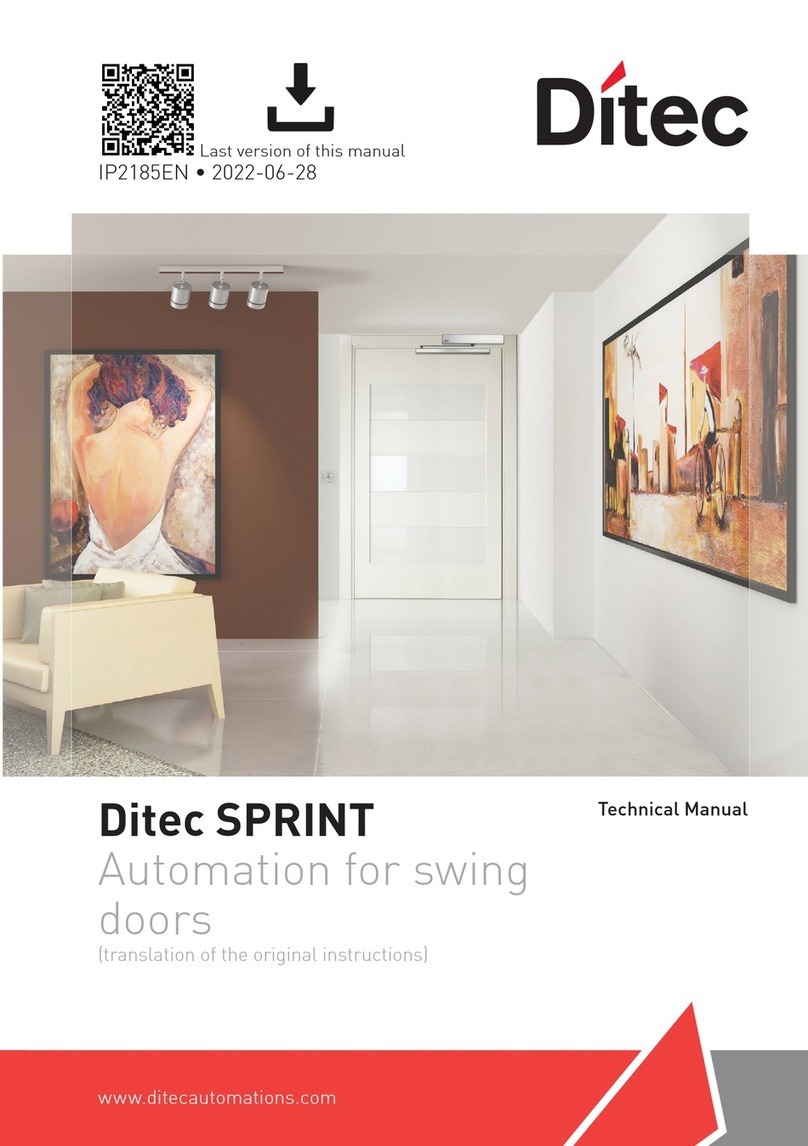
DITEC
DITEC Sprint User manual
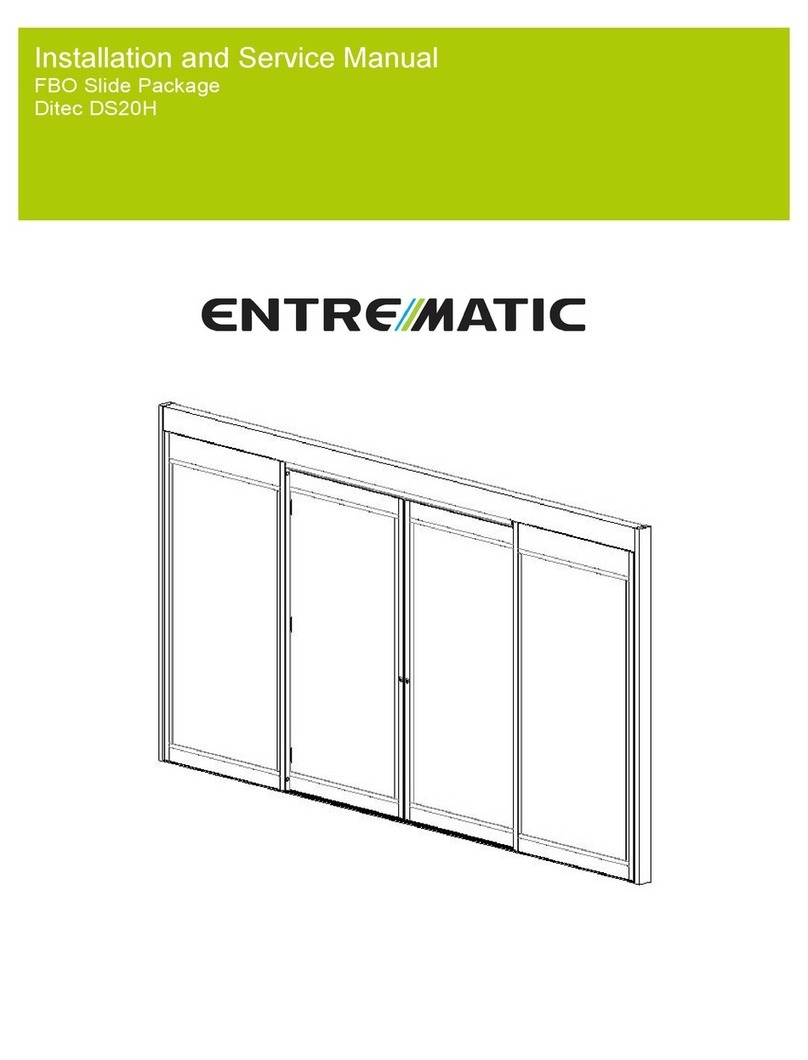
DITEC
DITEC Entrematic Hurricane DS20 Manual
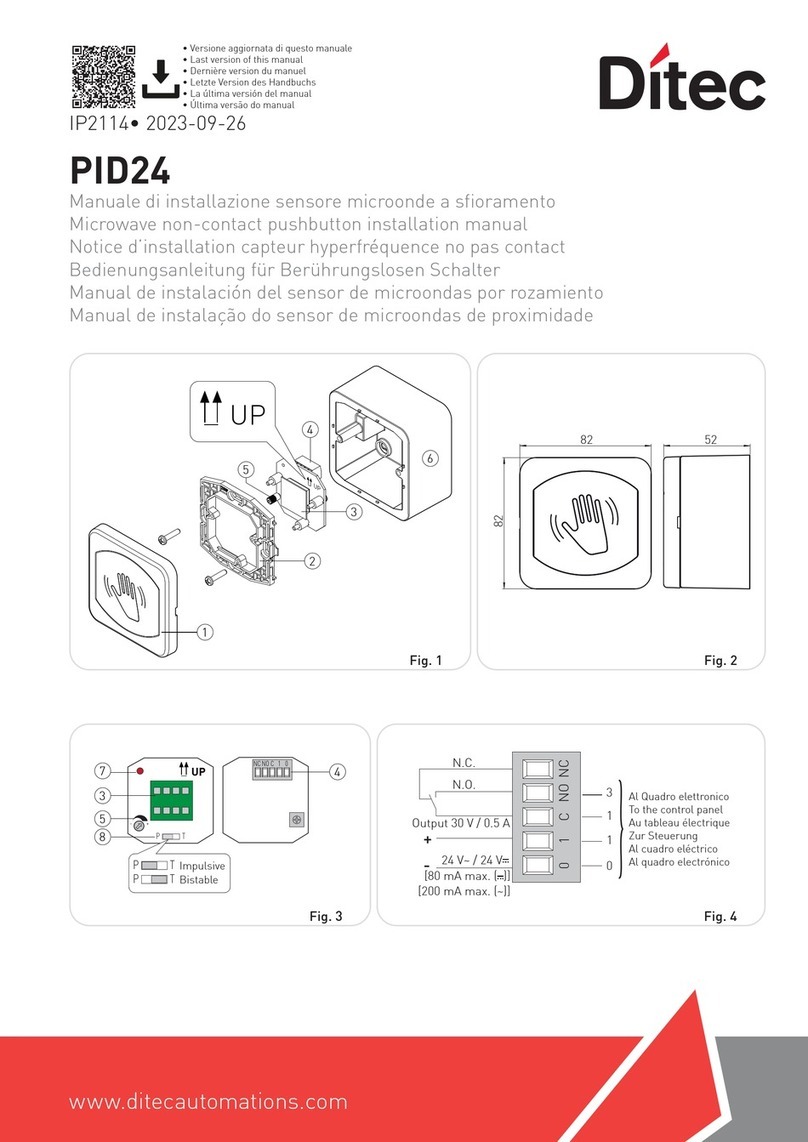
DITEC
DITEC PID24 User manual

DITEC
DITEC COM E User manual
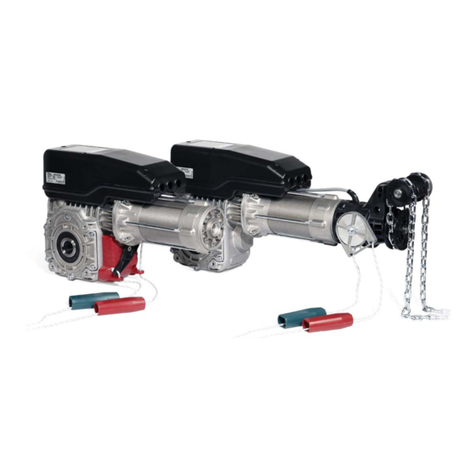
DITEC
DITEC NRG100TXE User manual
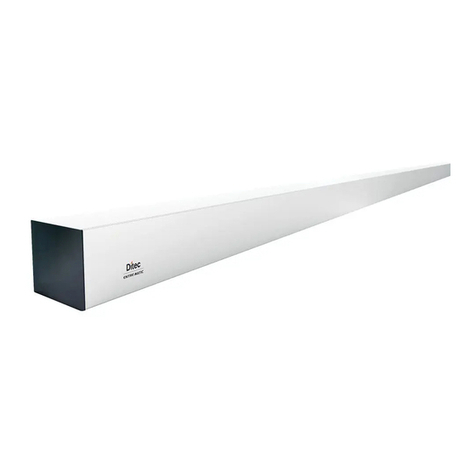
DITEC
DITEC DAS107PLUS User manual

DITEC
DITEC DAS900FM User manual

DITEC
DITEC entrematic HA8-LP Service manual
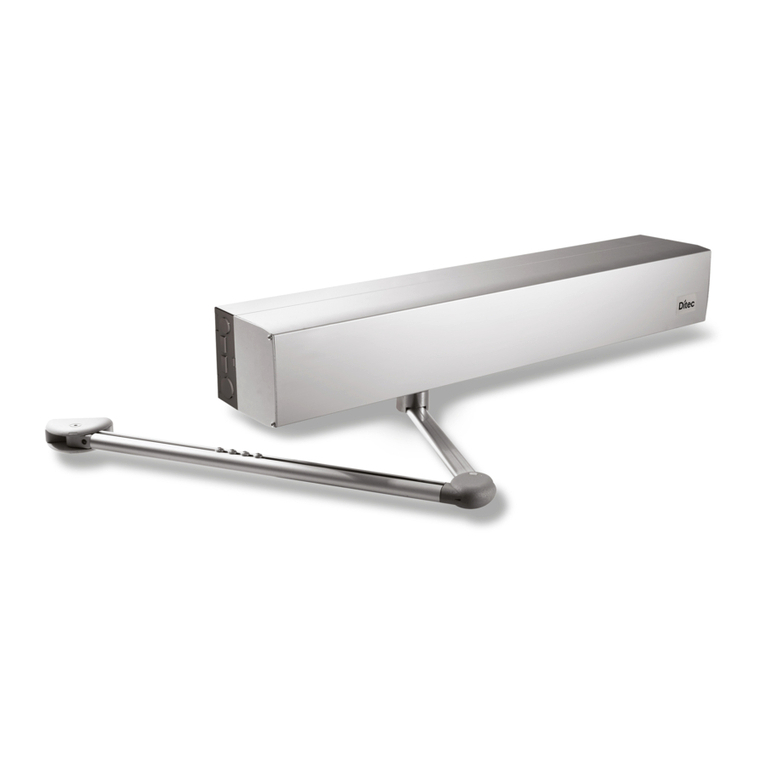
DITEC
DITEC DAB105 User manual
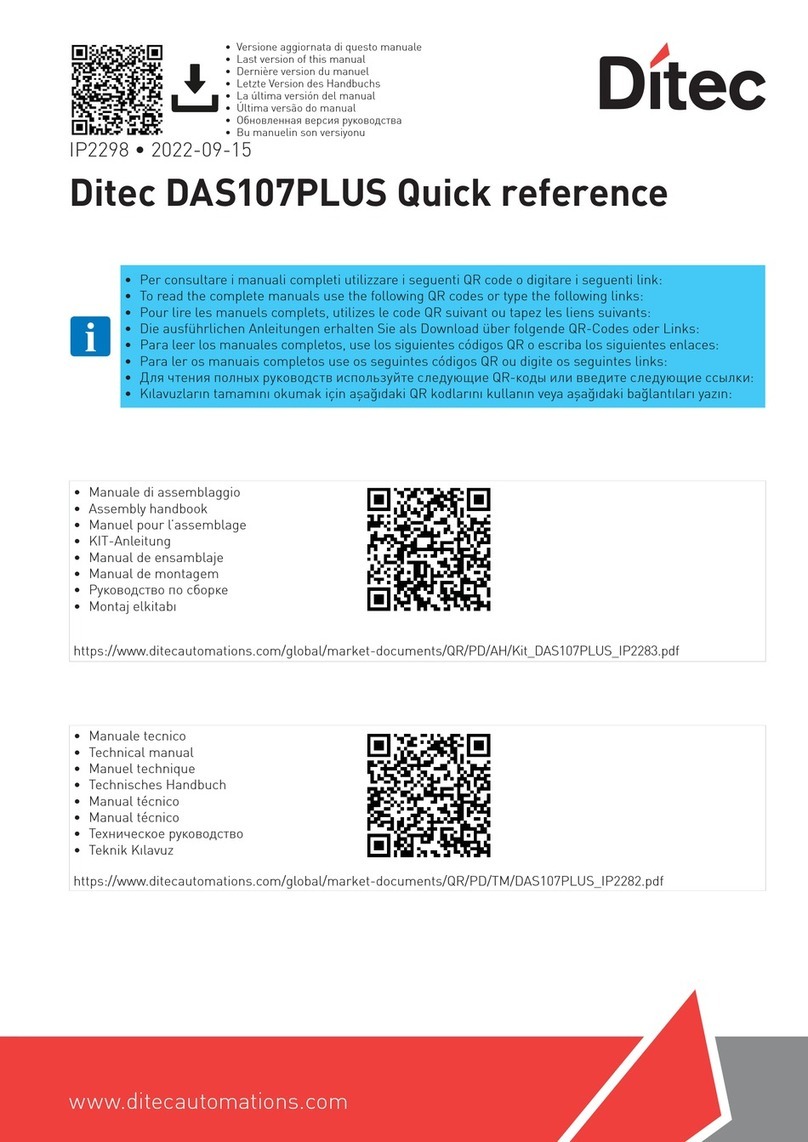
DITEC
DITEC DAS107PLUS User manual

